
Yes, you read that right – I have FOUR seasons of salvias in my garden.
Now keep in mind, I live in a temperate zone-9 climate, so my winter isn’t going to be like a Midwest winter.
But even if you live in colder areas, there are salvias for spring, summer, AND fall.
I went a little crazy when I moved here three years ago, ordering tons and tons of pollinator plants for my new garden.
I knew I wanted LOTS of salvias, as they’re long-blooming, deer-resistant, most are drought-tolerant, and they’d bring in every hummingbird and pollinator in the neighborhood.
My go-to online salvia site is Flowers by the Sea. It’s one of the most comprehensive sites I’ve seen, with every type of sub-category you could want designed to help you easily find the perfect salvia for whatever garden situation you might have.
Examples include shade, high-moisture, winter-blooming, salvias by specific color, or specific size – you name it, they’ve got them easily categorized for you!
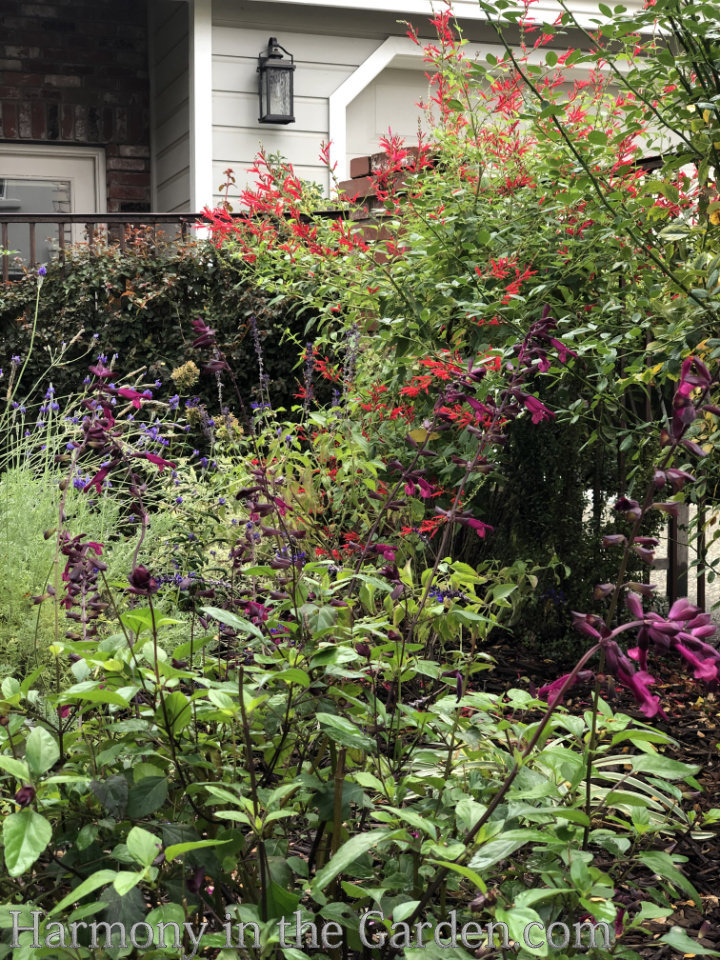
I often get asked about the difference between salvias and sages. The truth is that both terms of sage and salvia can be used interchangeably.
However, most people associate sages with the edible herb varieties, while salvias are associated with the ornamental varieties.
But really, they’re one and the same. Click here for a great article that goes into much more detail.
All the salvias I’m featuring below are those that are in my new garden, except for a small handful that are from my client’s gardens.
I have a lot to show you, so I’m going to jump right in, beginning with the season we’re in right now – Fall!
Fall Blooming Salvias
My garden is breathing a collective sigh of relief as the temperatures begin to cool down a bit, with salvias closing out the garden in style.
While we’re still having days in the 90’s, somehow it’s a cooler-feeling 90-degrees (if that makes sense?) Here’s what’s blooming right now:
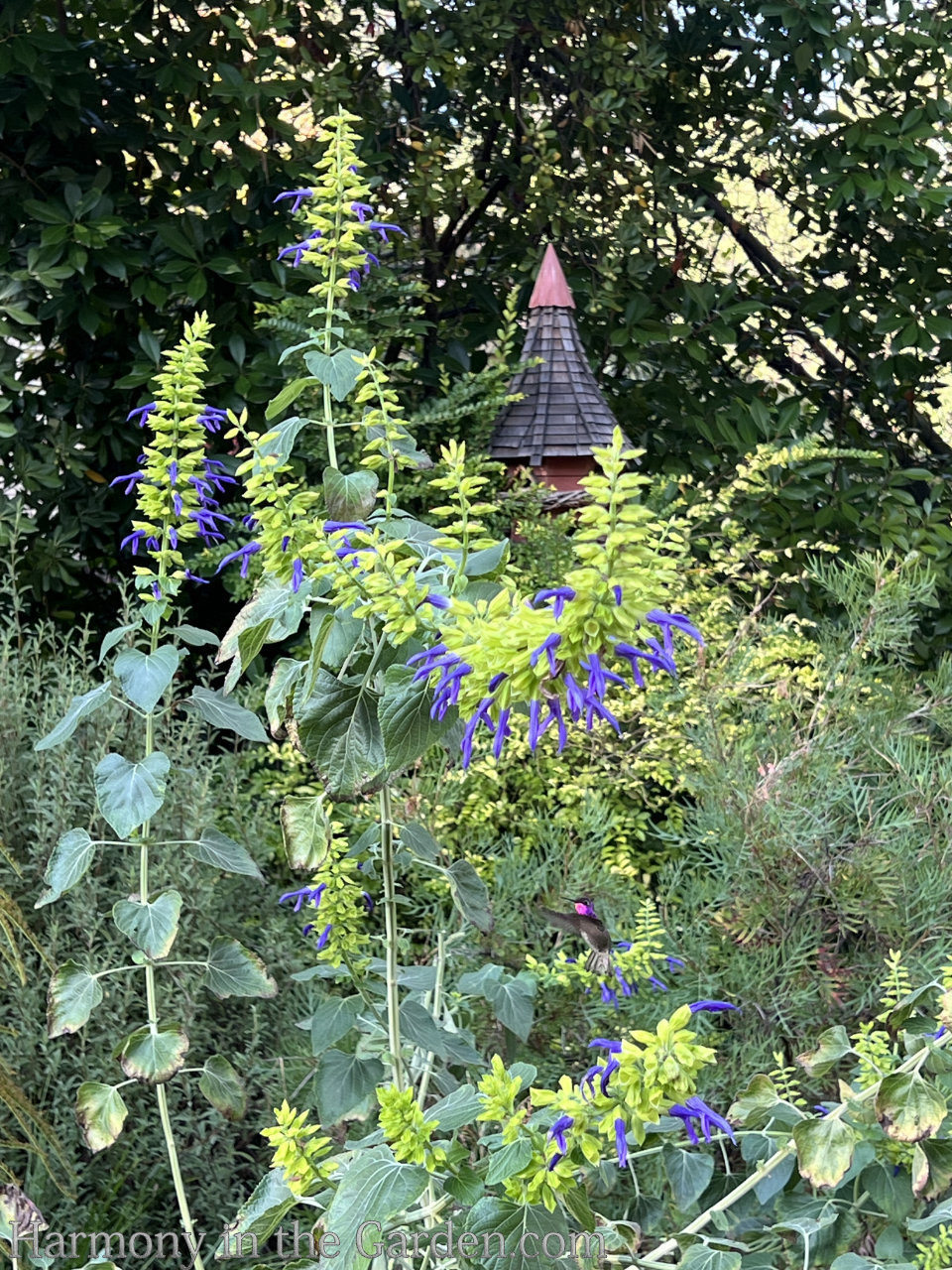
Salvia mexicana ‘Limelight’
Zones 8-11, part shade. Blooms September through January (sometimes longer!)
This is a big beauty for the back of the border, growing to a loose-shaped 6’x3’. I’ve grown this variety for years as it’s such a welcome color in the fall, playing off of all the yellows and oranges in the garden.
It has neon blue-violet flowers with chartreuse green calyxes starting late summer and lasting through December!
Hummingbirds absolutely adore the flowers, patiently waiting for me to stop taking photos before flying back to continue their feast.
Can you spot the hungry hummer who just couldn’t wait?

Salvia mexicana ‘Queretaro’
Zones 8-11, part shade. Blooms September through January (sometimes longer!)
This is really similar to the above ‘Limelight’, but is larger all the way around. It’s flowers are 8″ long (or more) and it grows to 8-10′ tall.
Since I have a fair amount of space, I love the giant beauties and have several of them planted in the back of the border.
I think the blue/purple flowers look especially vibrant when placed in front of the fall colors of the viburnum.
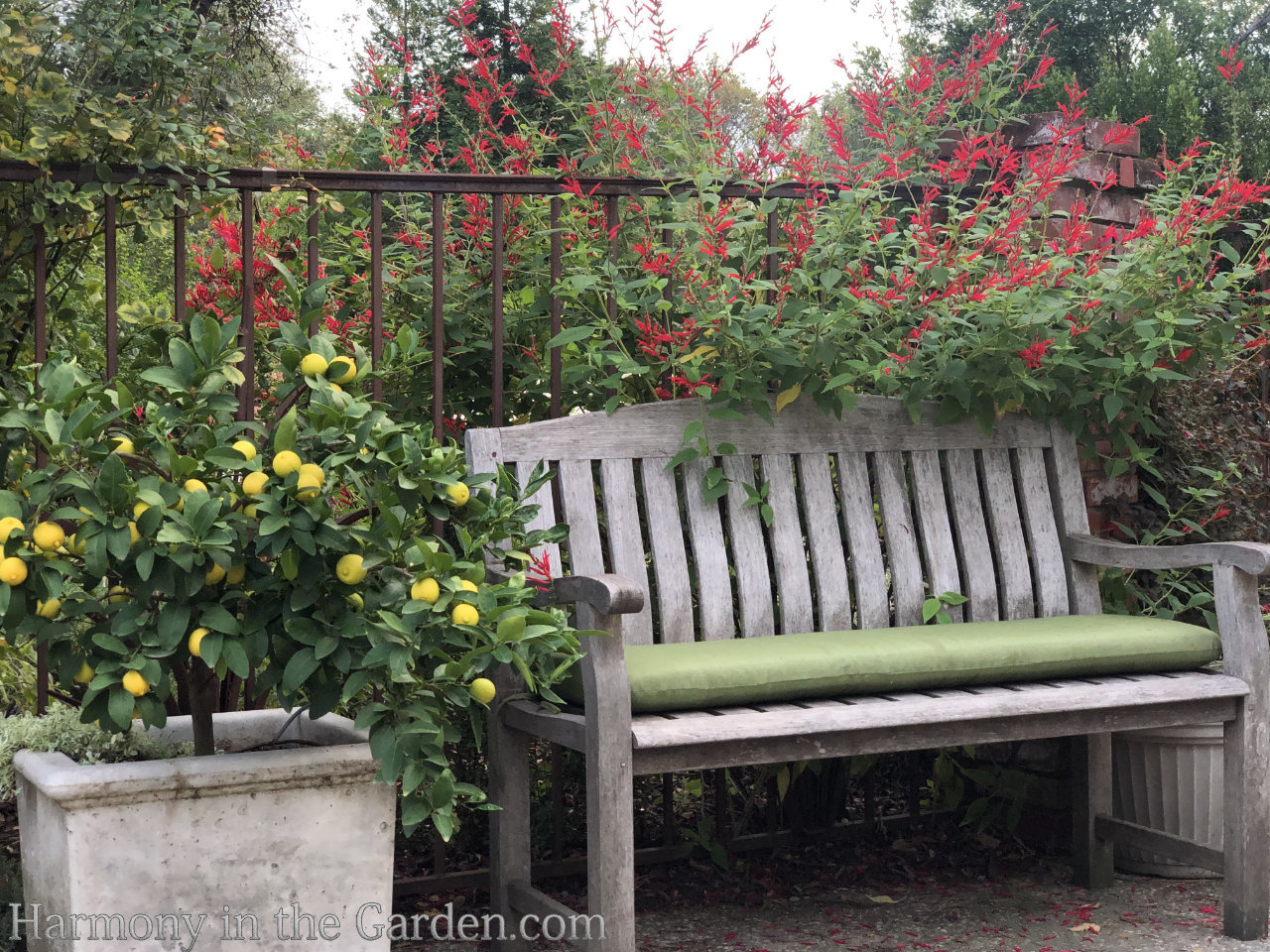
Salvia elegans (Pineapple Sage)
Zones 8-10, sun to pt. shade. Blooms October thru January
I’ve grown this edible (and DELICIOUS smelling) salvia for decades.
When my daughter was a toddler, she and my bunny that had free range of my garden, would devour this plant.
Between the two of them they’d keep it pruned to their height – about 2 1/2 feet.
Without grazing toddlers, it wants to grow 6’x4′.
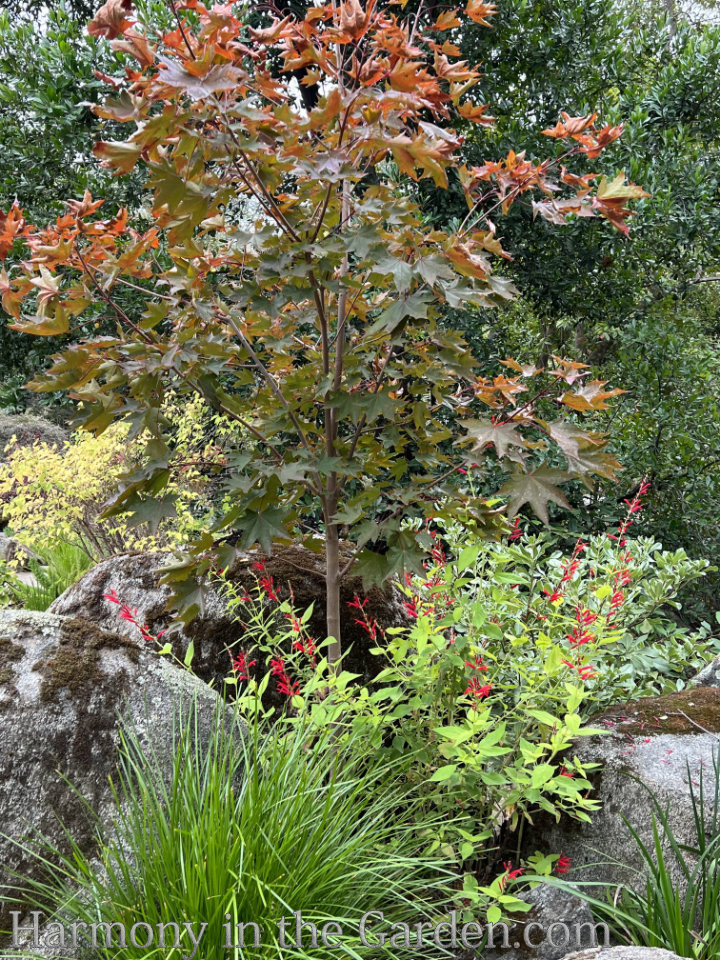
Salvia elegans ‘Golden Delicious’ (Pineapple Sage)
Zones 8-10, sun to pt. shade. Blooms October thru January
A smaller variety of Pineapple Sage, this one has chartreuse foliage and only grows to about 3’x3′. In this example, I have it planted to echo the colors of my ‘Crimson Sunset’ maple tree.
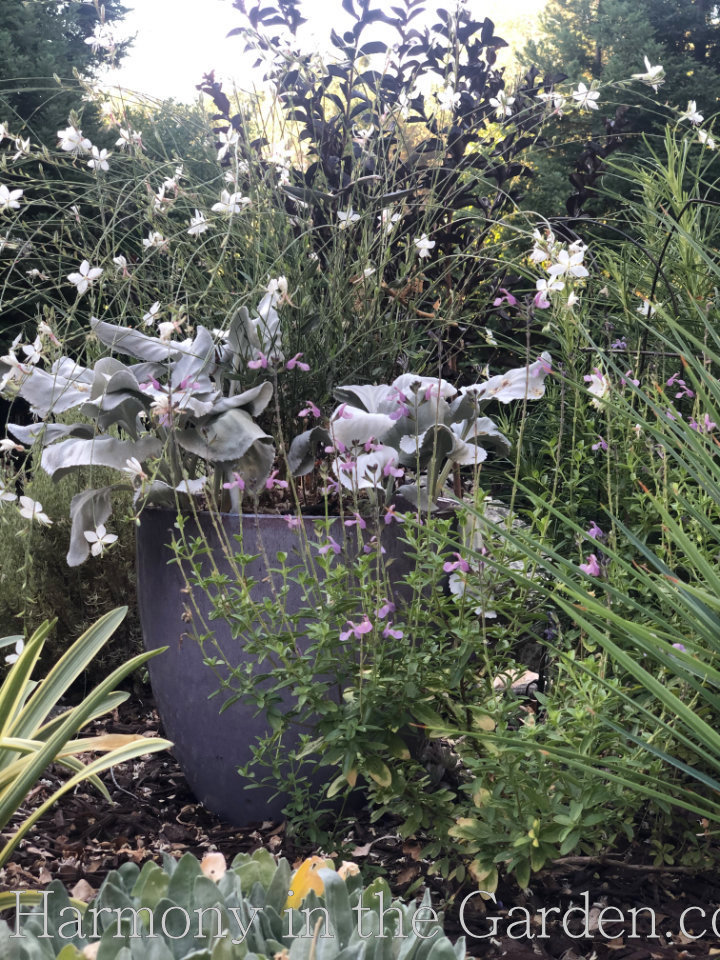
Salvia greggii ‘Smokin’ Lavender’
Zones 7-9. Blooms in May, then again in the fall. 2’x2′
There’s LOTS of s. greggii varieties (also called Autumn Sage), and they’re generally the ones with tiny leaves on wiry stems, with zillions of small flowers.
They often bloom heaviest in the spring, then when cut back by 1/3, they’ll re-bloom again in the fall.
I love the soft lavender color of this variety, and planted it in front of my lavender container to continue the color echo.
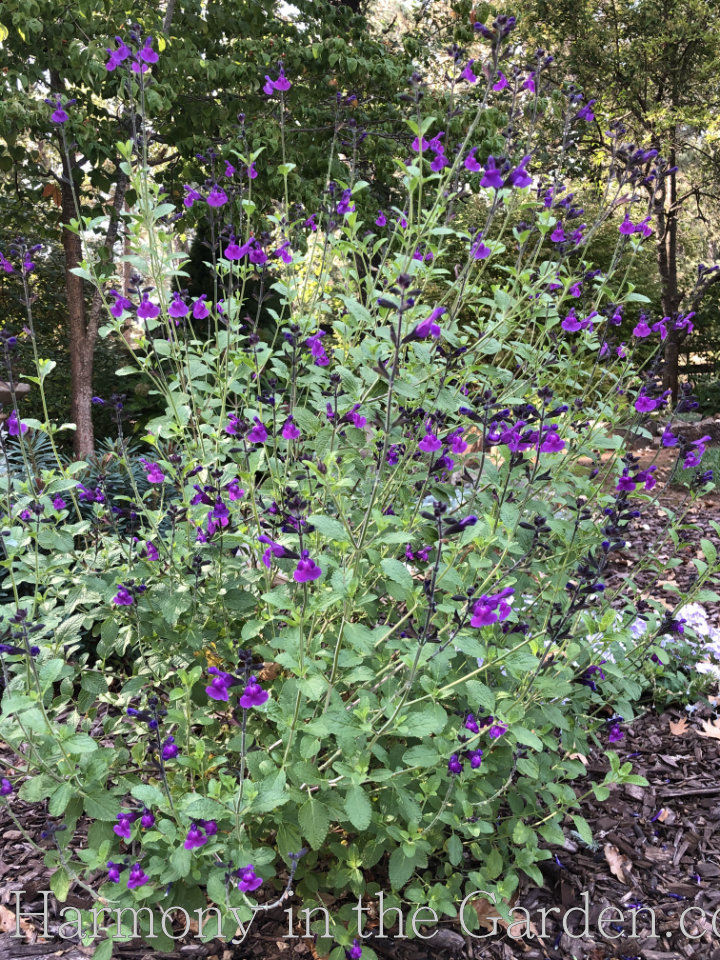
Salvia greggii ‘Mirage Deep Purple’
Zones 7-9. Blooms heaviest in fall, full sun. 2’x2′
Similar to the other purple salvias in my garden, I always appreciate colors other than yellow and orange. Don’t get me wrong – I love fall colors!
But I have TONS of yellow and oranges right now, and lush colors (like blues and purples) help visually tone things down.
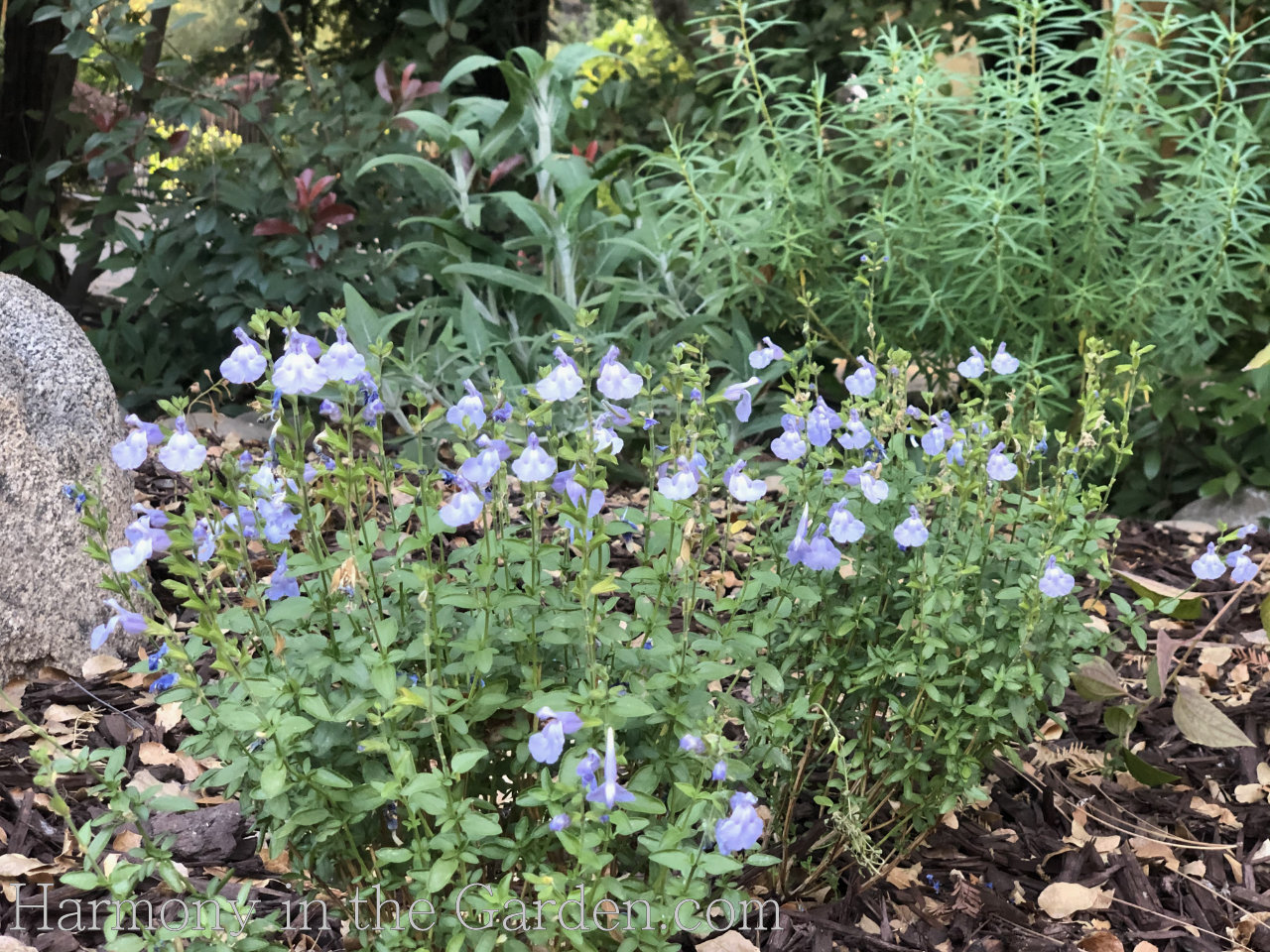
Salvia ‘Elk Blue Moon II’
Zones 7-9. sun to pt. shade. 2’x2′.
This variety seems to appreciate a little more shade in my blistering garden.
It puts on its best show in May, is pretty quiet through the summer, and is just now starting up for a repeat performance.
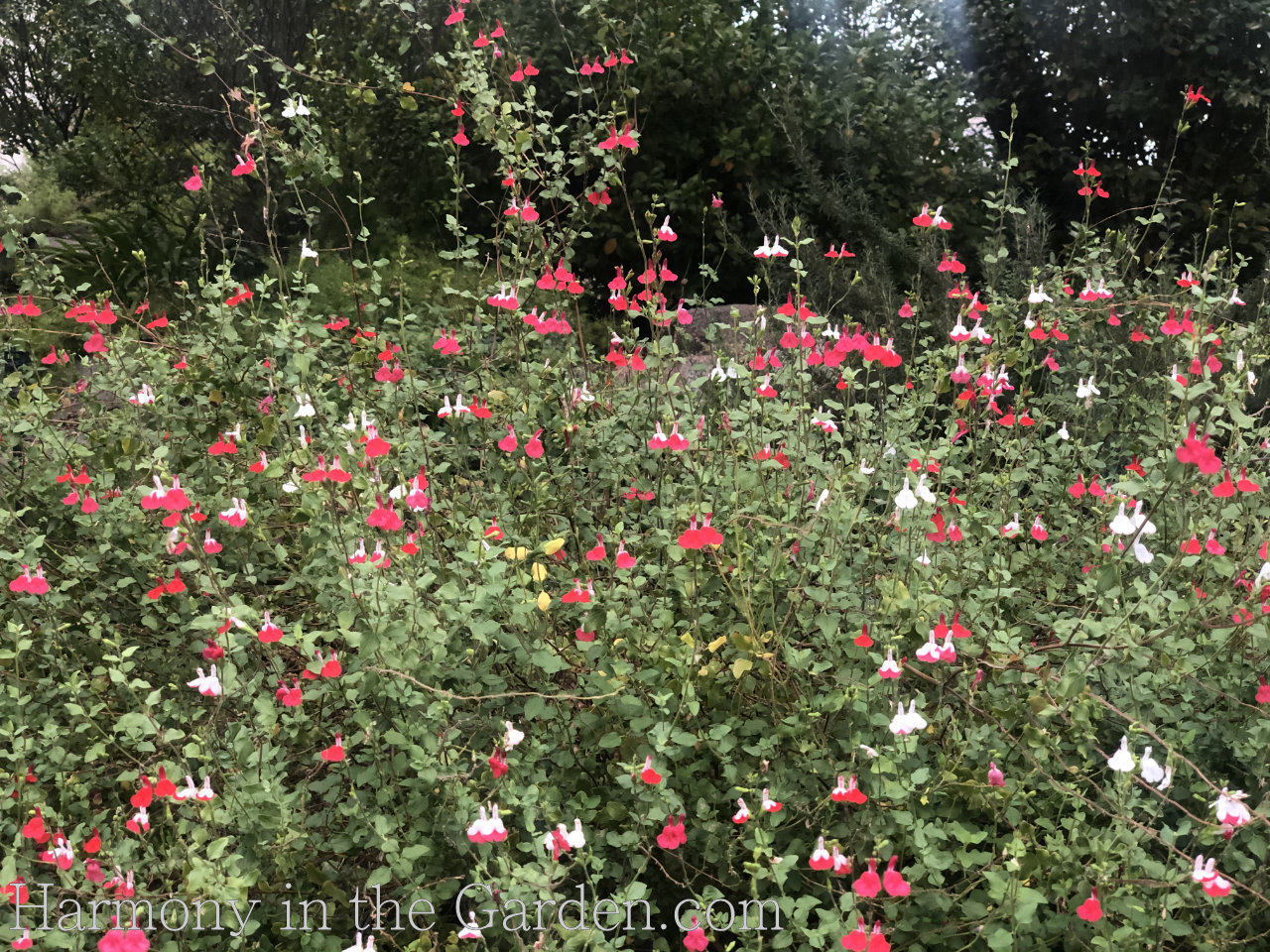
Salvia greggii ‘Hot Lips’
Zones 7-9. Blooms heaviest in fall, full sun.
I’ve had more clients deceived by the cuteness of ‘Hot Lips’.
Unlike a lot of other s. greggii varieties, this one quickly grows to 5’x5′!
It’s a biggie, for sure, but when placed in the right spot will draw in every hummingbird in town.
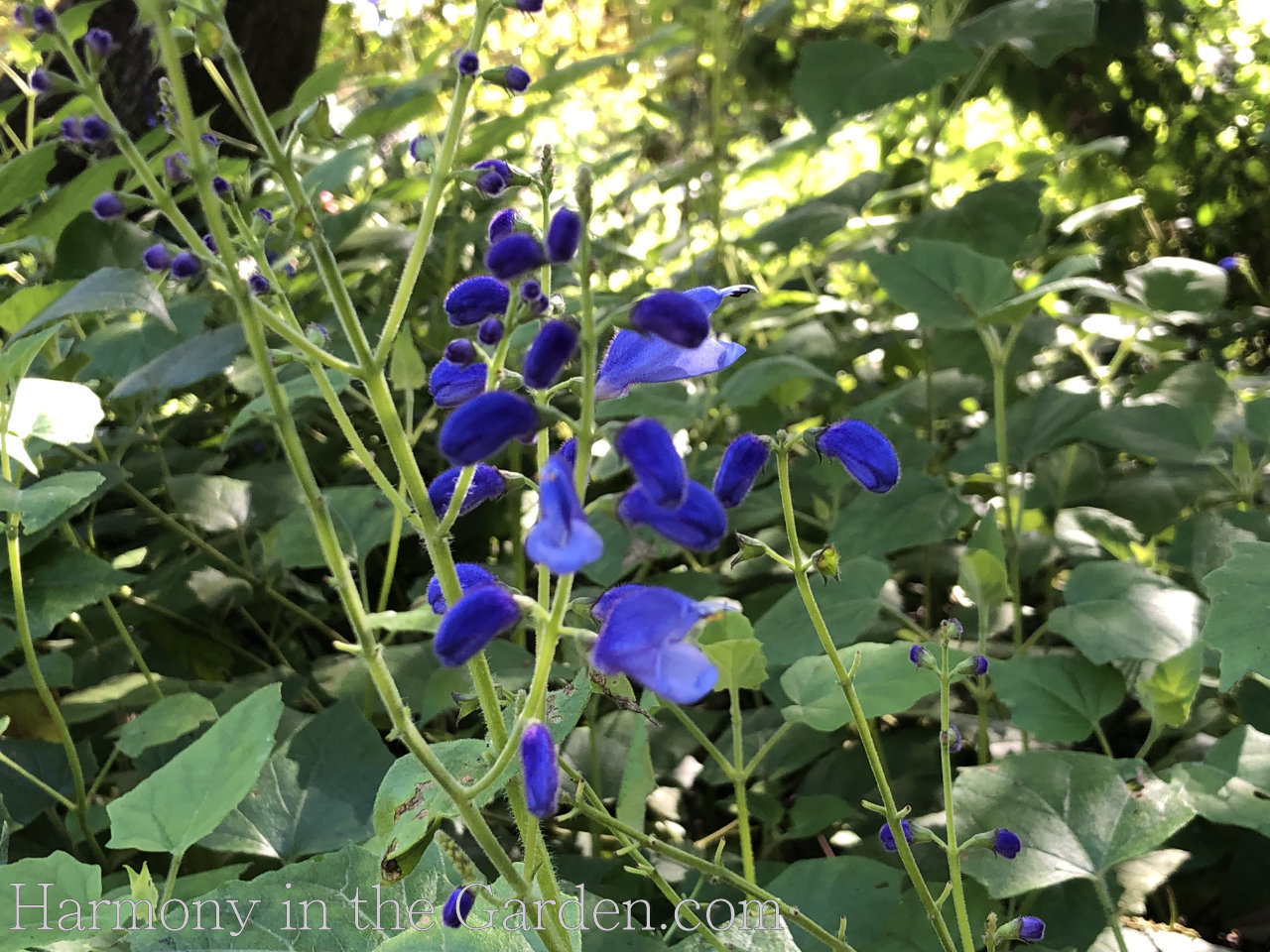
Salvia cacaliaefolia (Guatemalen Blue Vine Sage)
Zones 8-11, 3’x4’, bright shade with moderate water, blooms October thru December in my hot climate.
Naturally growing in the mountains of Southern Mexico, its rich blue flowers start making their appearance once the summer temperatures start to cool down.
There’s an outstanding example of this plant growing in the ‘Garden of Fragrance’ in the San Francisco Botanical Garden.
Winter Blooming Salvias
While many salvias are dormant in the winter months, there are a few that will bloom through February in my zone-9 garden. I’ll take salvias in February any ‘ol time!
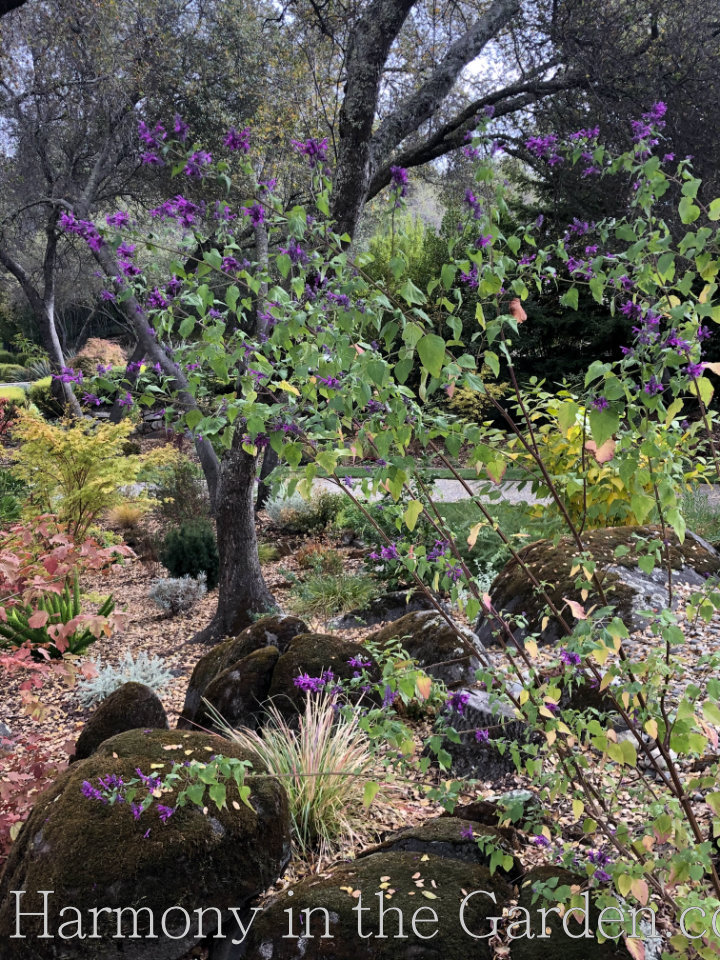
Salvia purpurea ‘Lavender Lace’
Zones 9-11, pt. shade in my hot climate, quickly grows to 8’x6′.
Blooms OCTOBER THROUGH JANUARY!
Not only does this flower begin blooming in late October, but it continues with TONS of flowers all the way through January.
And it’s super fast growing, too. This is my plant 1 ½ years later, after arriving in a 4” pot from Flowers by the Sea (unfortunately, they’re out of business now.)
It’s had an additional year of growth under its belt and it’s at a towering 7’feet!

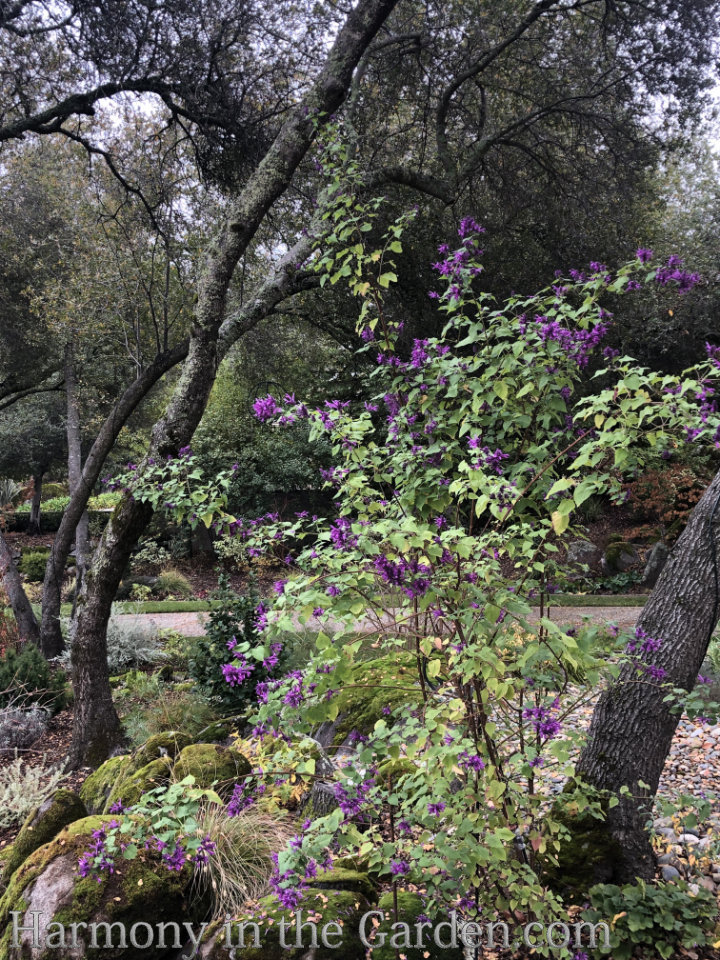
Here it is again, blooming like mad in mid-January!
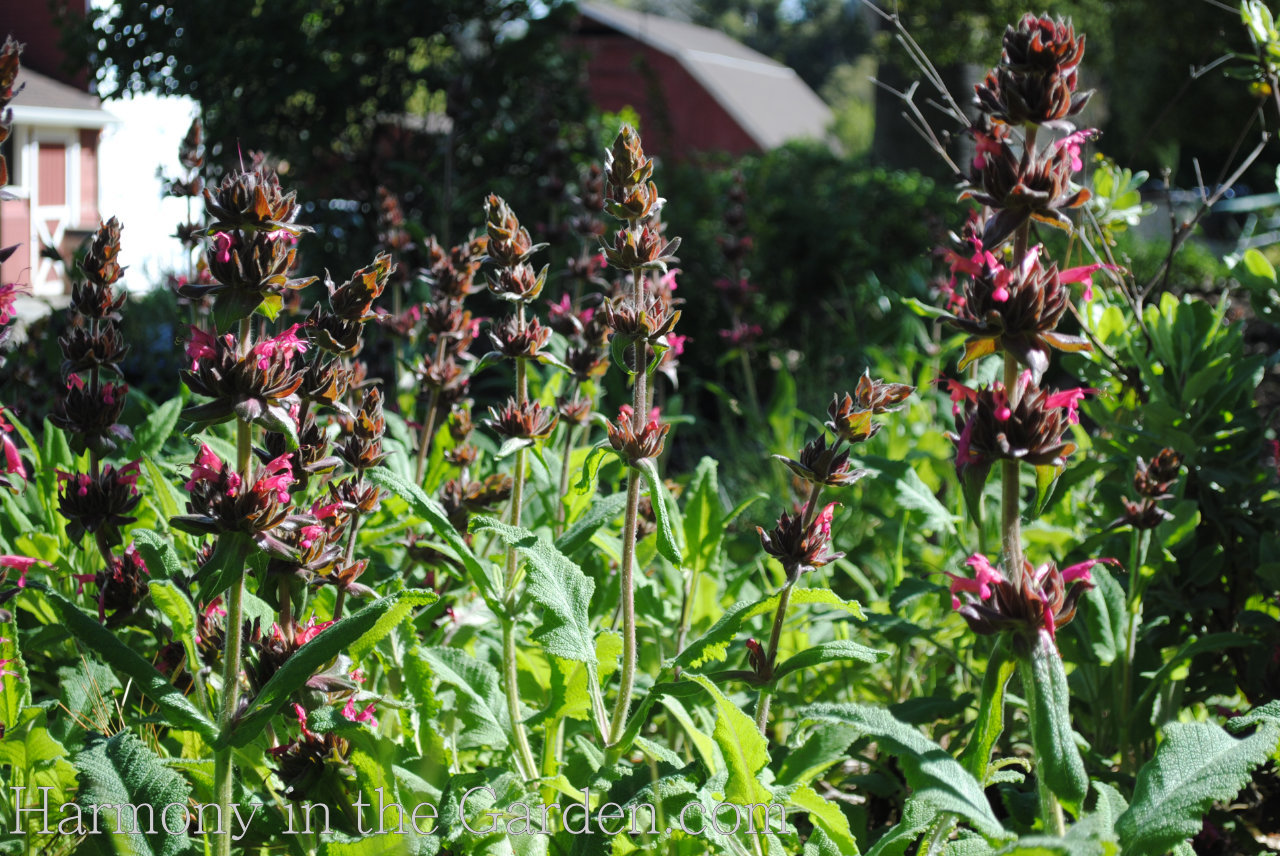
Salvia spathaeca (Hummingbird Sage)
Zones -10, full sun, grows 1′-3′, sprawling wider by rhizomes. Blooms late February through May.
This California native, has oversized magenta flowers that are ADORED by hummingbirds. (click here for my Top 30 native plants!)
Touch the flowers, and your hand will feel slightly sticky, yet silky. It’s almost like nature’s hand lotion. And the fruity fragrance is divine!
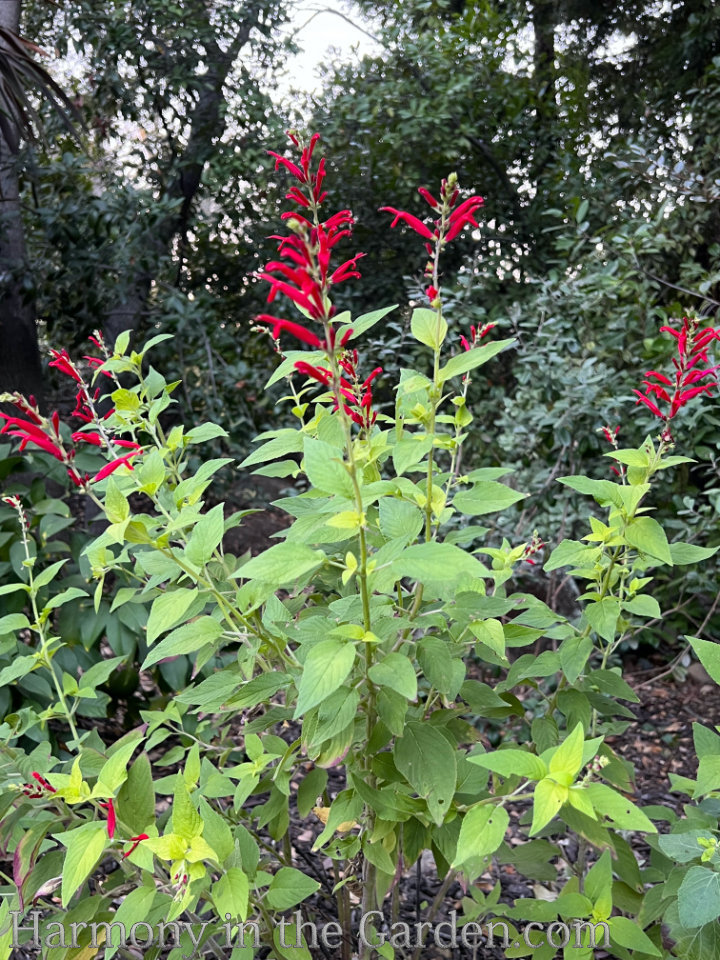
Salvia elegans ‘Golden Delicious’ (Pineapple Sage)
Zones 8-10, sun to pt. shade. Blooms October thru January
I talked about Pineapple Sage above, but in a mild winter, it’ll continue to bloom well into February.
Here’s a tip – it’s easy to start cuttings of many types of salvias, like Pineapple Sage. Just stick a stem in water and watch the roots form within a week or so.
Then, transplant to a container with good potting mix and let it continue to root.


Besides the varieties that bloom in the winter, there are lots of others that have foliage that remains above ground.
And even though they may not be blooming, I appreciate having something in the garden on a cold and wintery day!
Those include the salvia argentea (shown left and below) with its amazing fuzzy foliage, as well as s. Clevelandii ‘Winifred Gilman, White Sage (s. apiana), salvia occidentalis (all of which I’ll discuss further down the article.)

Spring & Summer Blooming Salvias
Most salvias bloom in the spring and summer months, which is why I’ve grouped these two seasons together.
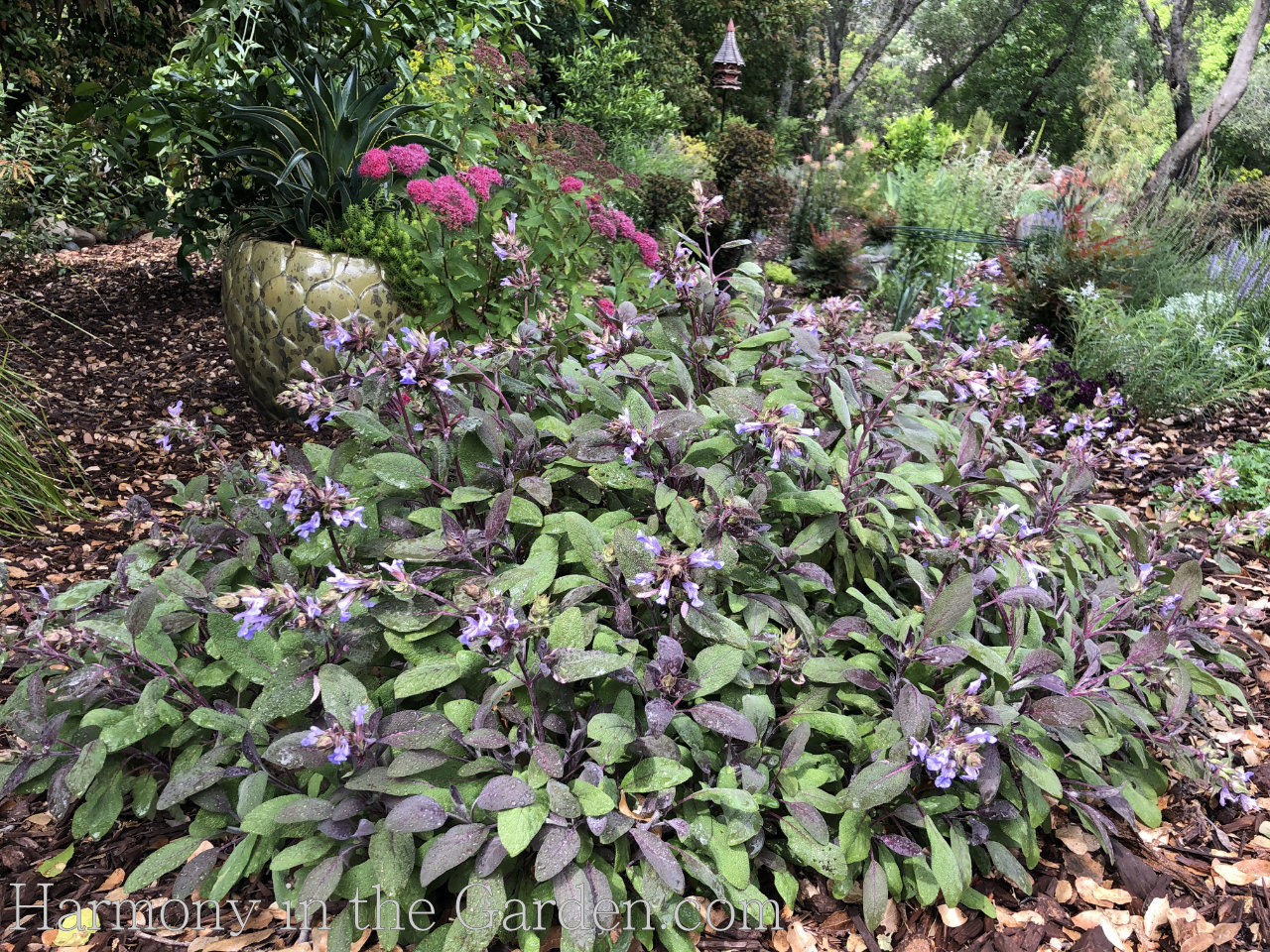
Salvia officinalis ‘Purpurascens’
Zones 6-9, full sun, blooms in late spring, though the foliage looks fantastic throughout most of the year.
This salvia is fantastic for cooking as well as providing amazing foliage in an ornamental garden bed, and is a perfect addition to my Pollinator Garden.
I use it all the time in my designs, as it forms a lush 2’x3’ mat of soft plum/gray/green. I use it at the front of the border, as well as to hide the stems of leggier plants (ie: verbena bonariensis, sedum ‘Autumn Joy’, etc.)
After a few years it can become leggy and bare in the center, at which point I give it a hard hair-cut (no lower than 8”.) After a few weeks, it’ll become a lush mound once again. Other varieties of salvia occidentalis are the green and white ‘Variegata’ and the purple, green and white ‘Tri-Color’ (both shown below.)

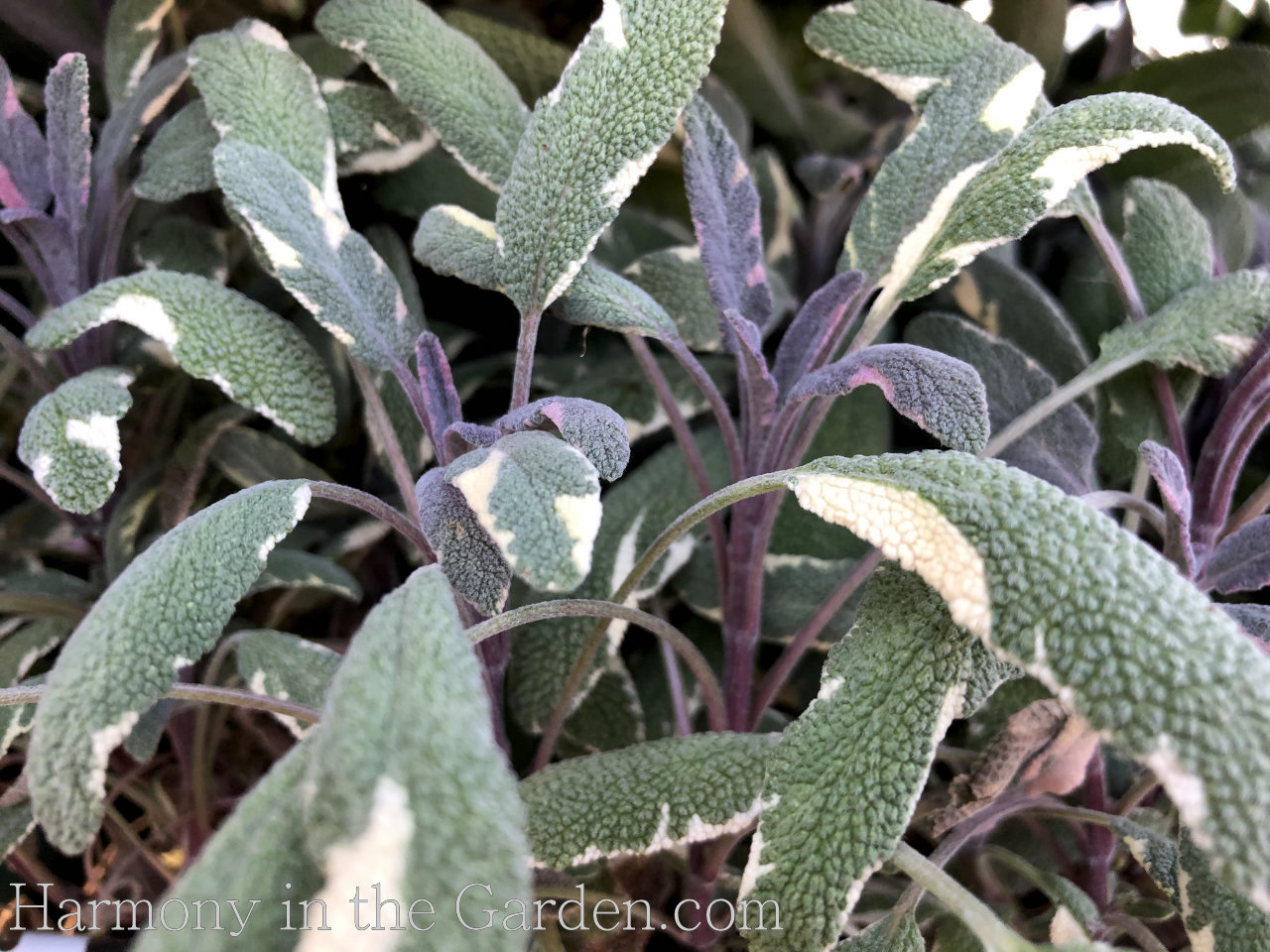

Salvia ‘Dara’s Choice’
Zones 6-10, full sun to pt. shade,
This is a sweet little native hybrid of Sonoma Sage (salvia sonomensis) and Black Sage (salvia mellifera.)
It’s a low-growing, evergreen salvia reaching 1 1/2′ x 3′ wide and is one of the first to bloom in the early spring.
You can see just how early it blooms, with the narcissus ‘Avalanche’ blooming behind it.
It’s leaves have that wonderful smell that reminds me of hiking in the hills, and it’s oversized 5″ lavender blooms are long-lasting (mine are going on 4 weeks now!)
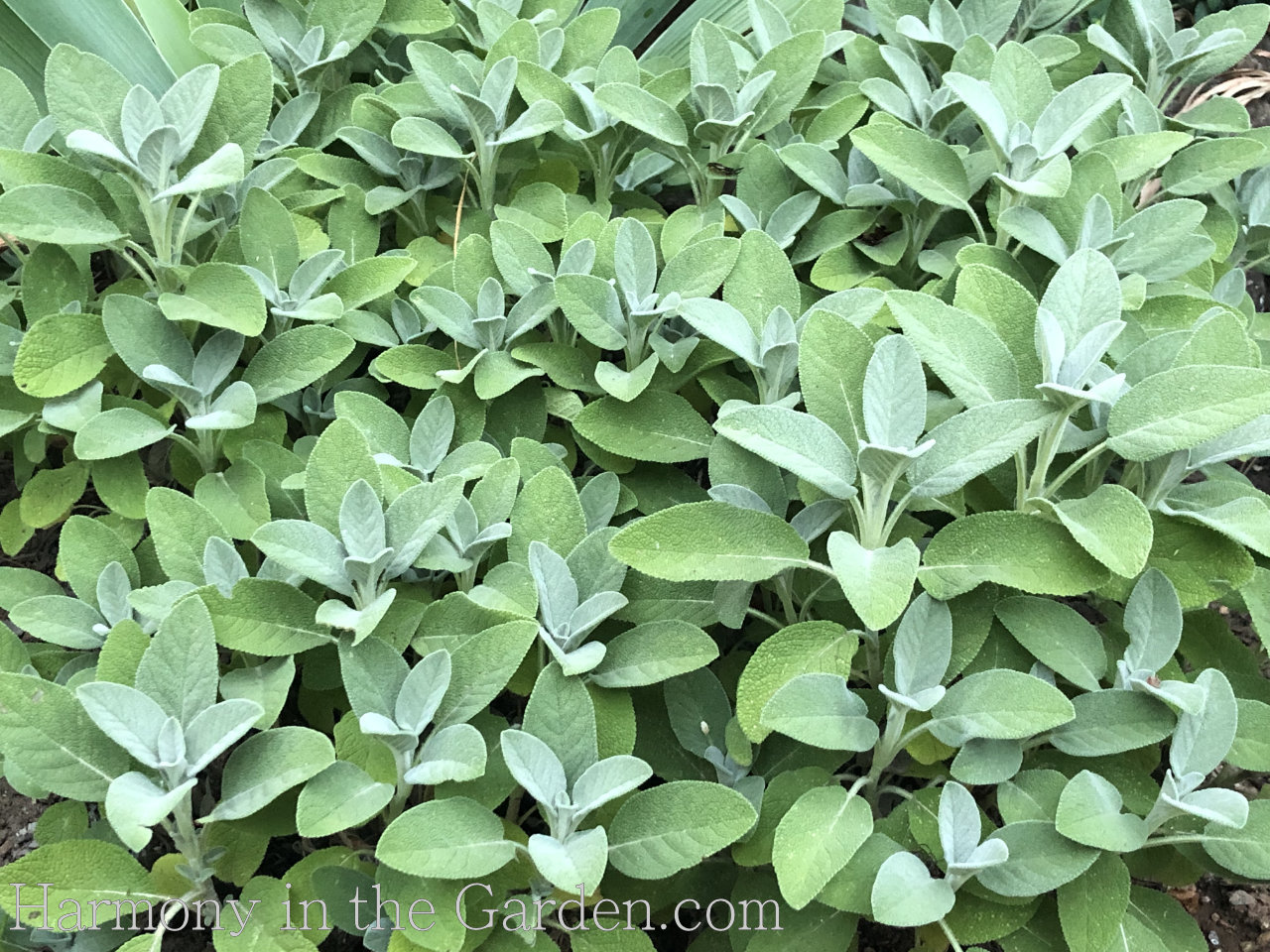
Salvia officinalis ‘Berggarten’ (Bergarten Sage)
Zones 6-10, full sun to pt. shade,
This is another variety of salvia officinalis (like the ones, above) that I use ALL THE TIME in my designs.
Blooms sporadically March thru July, but I prefer it’s tidy 2’x3′ mound of oversized silvery-green foliage to its flowers.
Like the other varieties, I use it to hide other leggy plants, pruning back by 2/3 when it starts to look ratty. Give it a few weeks and it’ll bounce right back again!
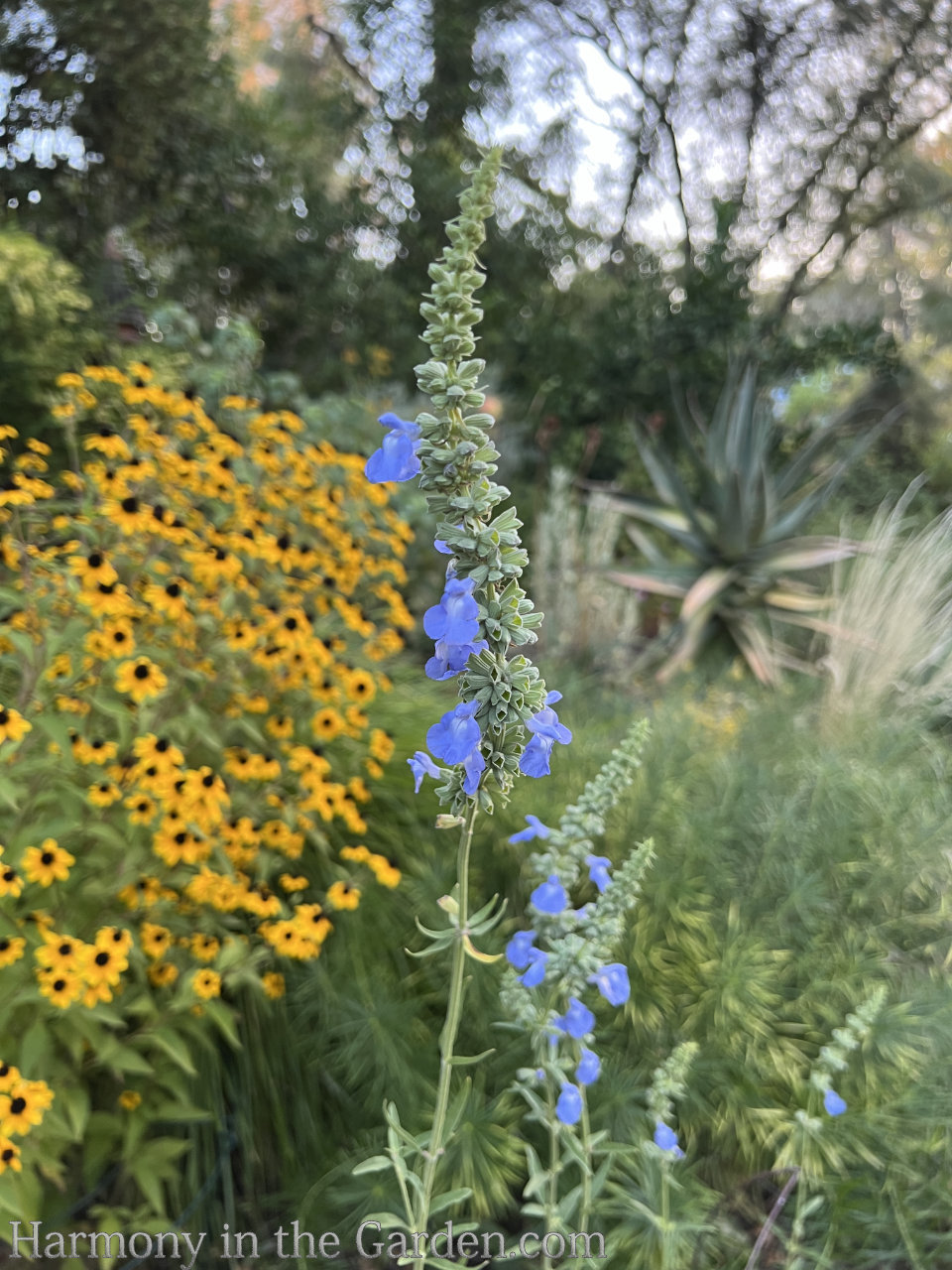
Salvia azurea (Blue Sage)
Zones 4-9, deer-resistant
Another favorite on-line source is Prairie Nursery, which is where I purchased this tough-as-nails salvia.
In addition to my penchant for prairie plants, I also love anything that’s oversized.
Which is why I just had to have this unusually tall variety of salvia, which grows to 5-feet, and is a summer highlight in my Modified Meadow Garden.
It tends to flop, however, so it will definitely need staking.
But seeing those sky-blue flowers swaying in the back of the border make the hassle of staking the plant worth it.

Salvia ‘Mystic Spires’
Zones 7-12, full sun, blooms summer through fall.
This one of my favorite long-blooming, deep purple salvias – ‘Mystic Spires.’
You’ll notice that in the photo below, is a Bergartten’s Sage planted in front of ‘Mystic Spires’. Isn’t it a fantastic combination?
And talk about long-lasting! It flowers for 4-5 months, at least.
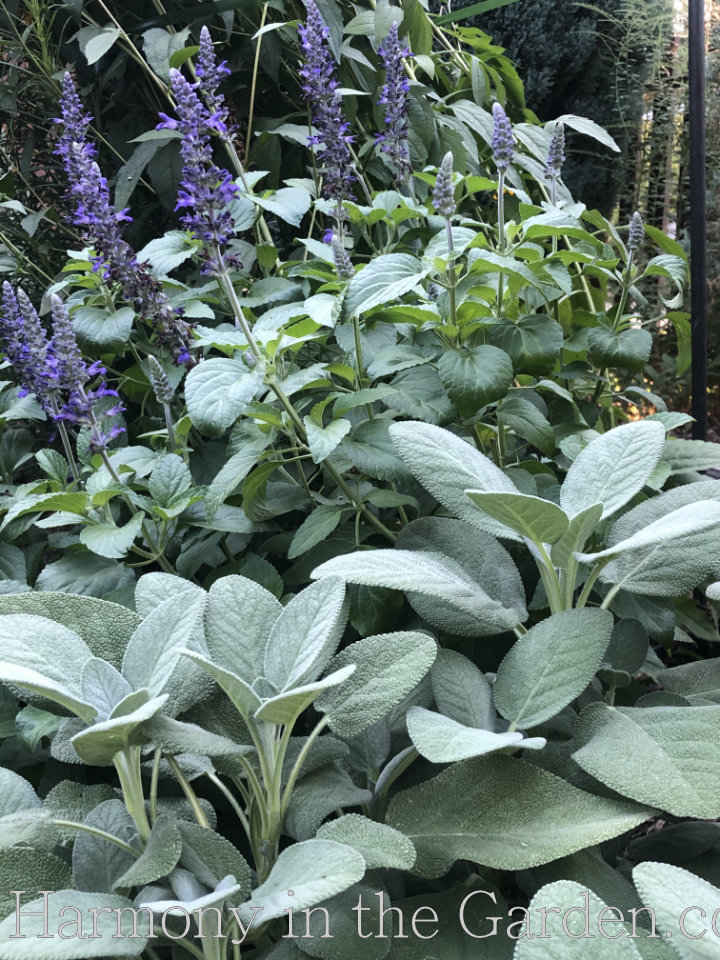
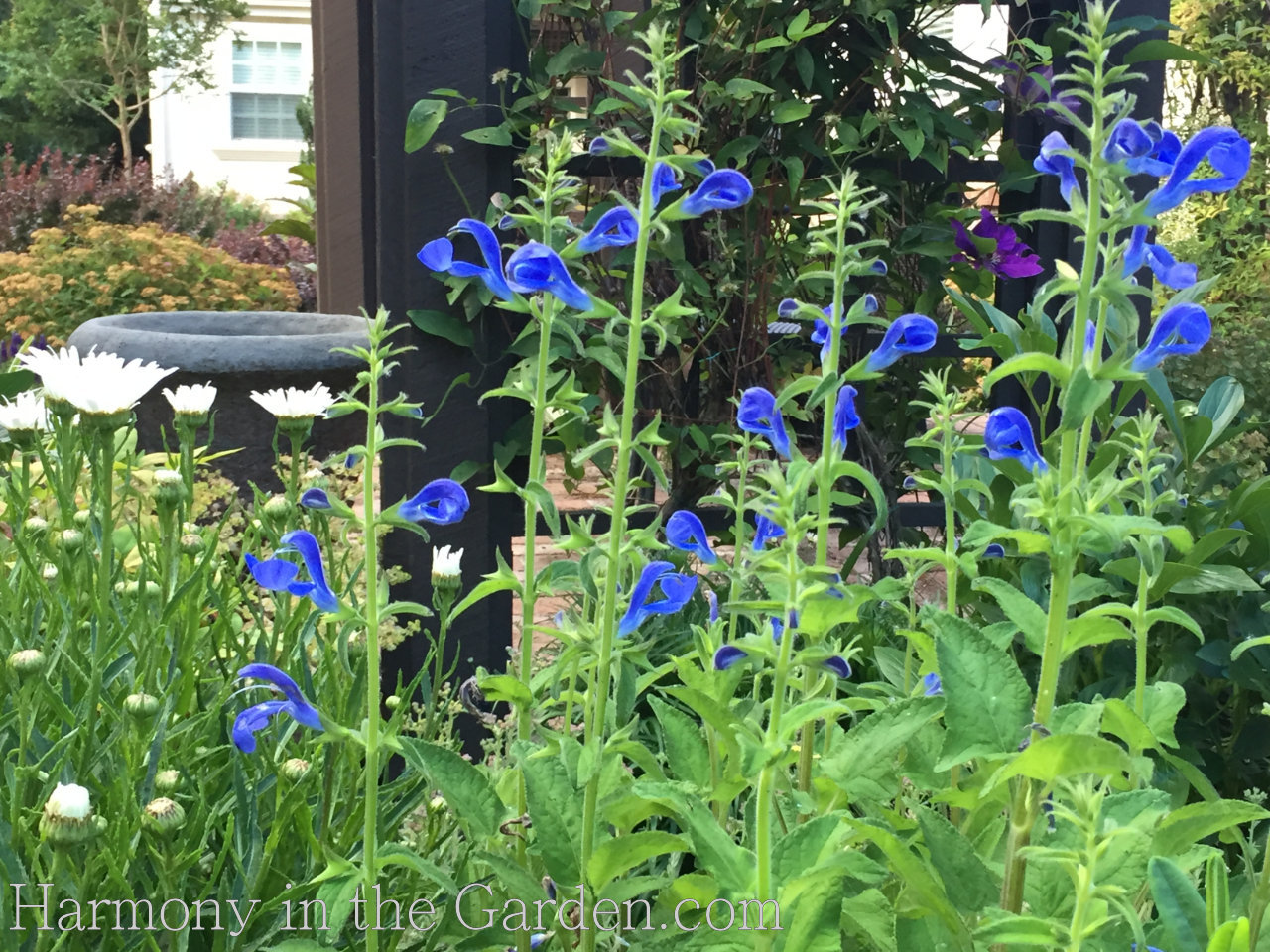
Salvia patens ‘Patio’ Deep Blue
(Gentian Sage) Zoes 8-11, pt. shade. 18″x18″
A treasured salvia in my garden, the true-blue flowers begin appearing in late summer, lasting through September.
Mine grows best with partial shade (especially in my HOT climate) and a bit more water that the other salvias I mention.
Want to know why I love the Flowers by the Sea site so much? Read this interesting article explaining why true-blue colors are so rare in nature.
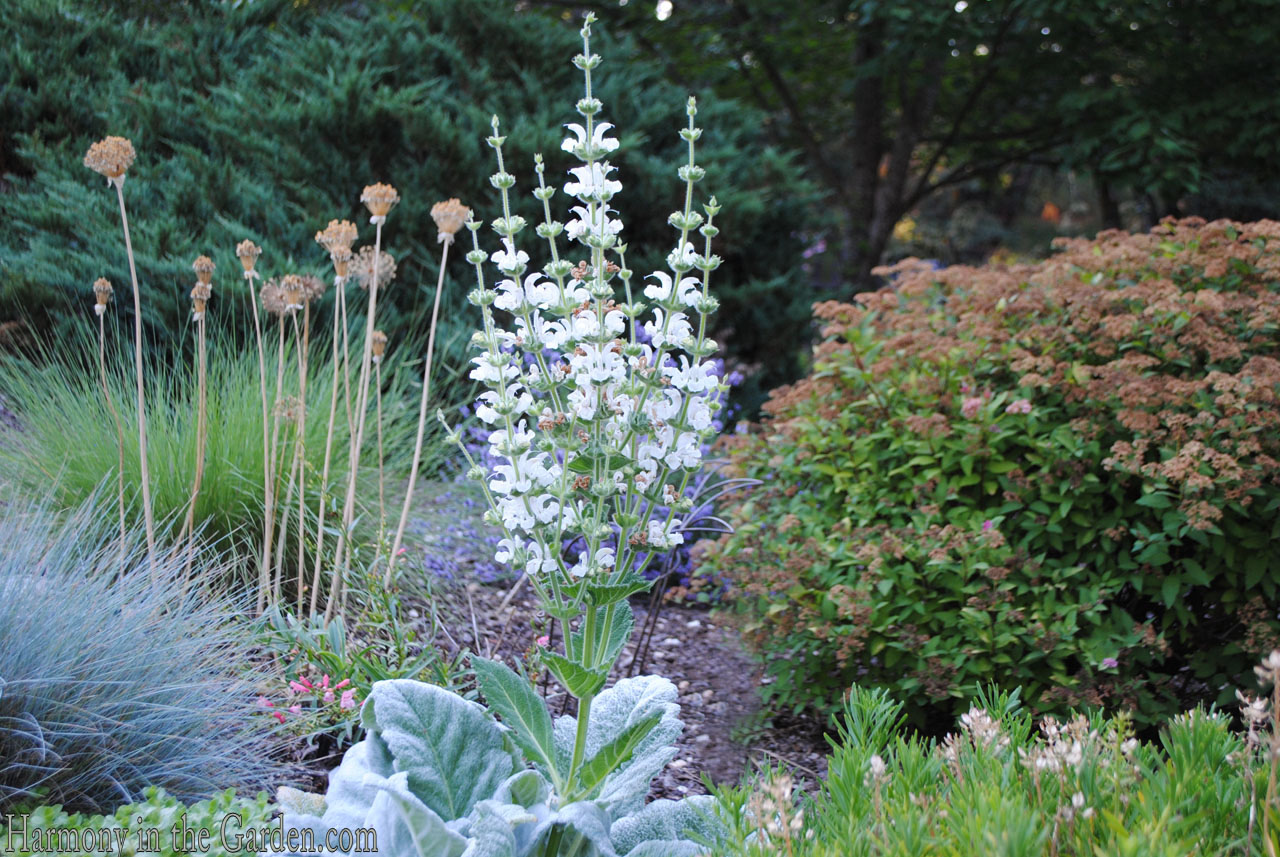
Salvia argentea (Silver Sage)
Zones 5-8, full sun, shorter-lived perennial (maybe 5 years or so?)
While the white candelabra flowers are lovely, most people grow Silver Sage for the oversized, downy can’t-resist-touching-it foliage that I featured above.
Textural foliage plus stunning flowers? No wonder people go crazy for this salvia.

Salvia canariensis (Canary island Sage)
Zones 9-10, full sun, quickly grows to 5’x5′ and more!
Another super fast growing salvia, reaching 5’ in a single season!!!
I first saw this at the Sacramento Historic Cemetery, and HAD to have it. I love its oversized silvery-gray foliage, which is a highlight in and of itself.
It has zillions of flowers with an unusual rosy-pink color that are HUGE (12” long, at least!) and are very long-lasting.
I cut mine back to 2-3’ in the winter, where it quickly forms a tidy mound of foliage for the rest of the year.
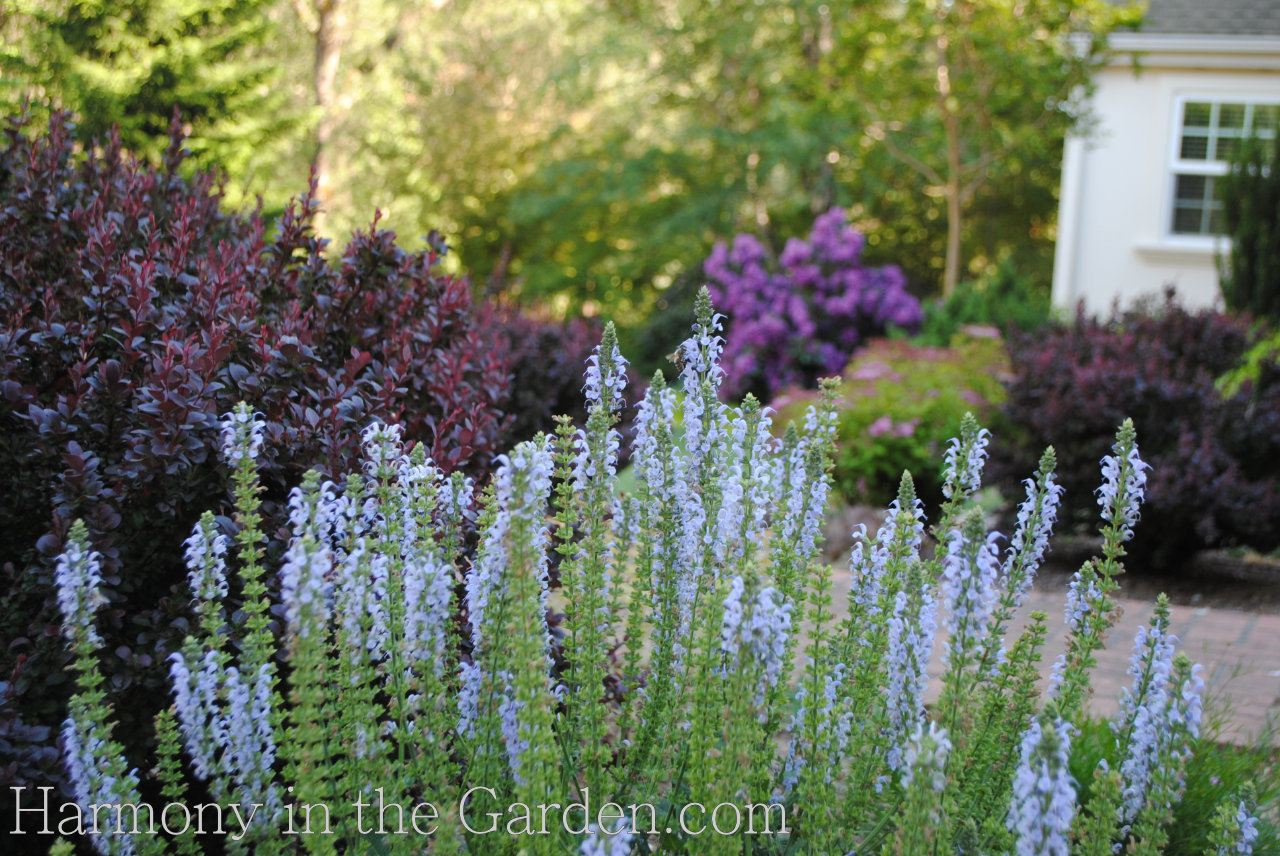
Salvia nemarosa ‘Crystal Blue’
Zones 3-8, full sun, 2’x3′
Proven Winners sent me this variety several years ago to trial in my garden, and I’ve been using it ever since. It can be hard to find (I order mine through their website) but it’s so worth it.
Deadhead the spent flowers, and you’ll be rewarded with months of summer light blue blooms.
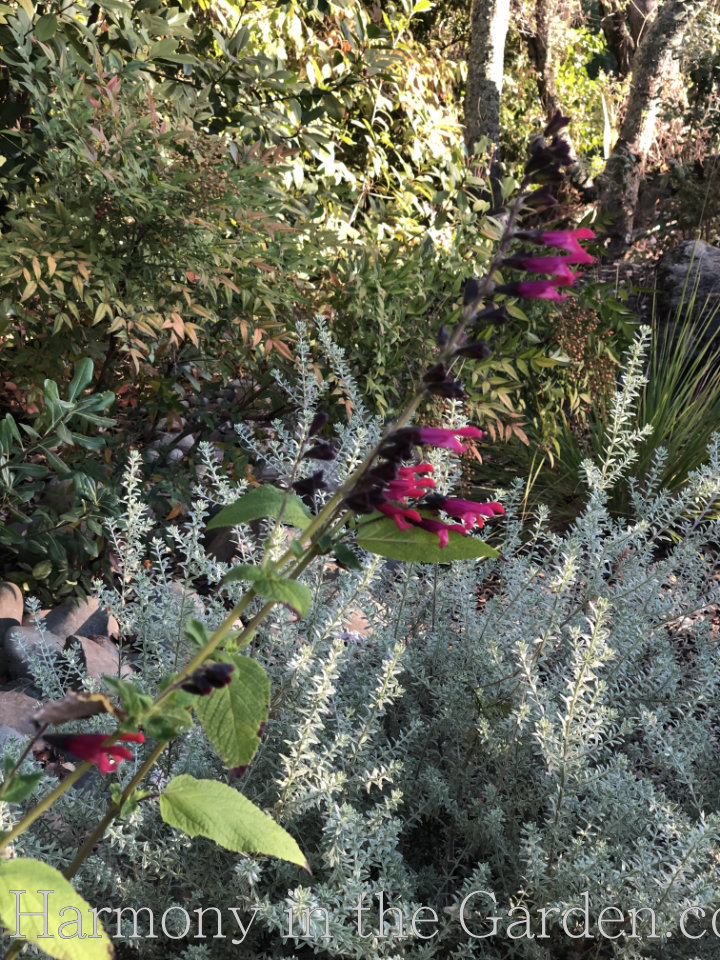
Salvia ‘Amante‘ and ‘Amistad’
Zones 8-11, full sun, 6’x4′
Salvia ‘Amante’ (magenta flowers) and ‘Amistad’ (purple flowers) are cousins, and are both GIANTS for the back of the border.
They’re COVERED with blooms summer thru November (sometimes December!) and both will lure every hummingbird in the neighborhood to your garden!
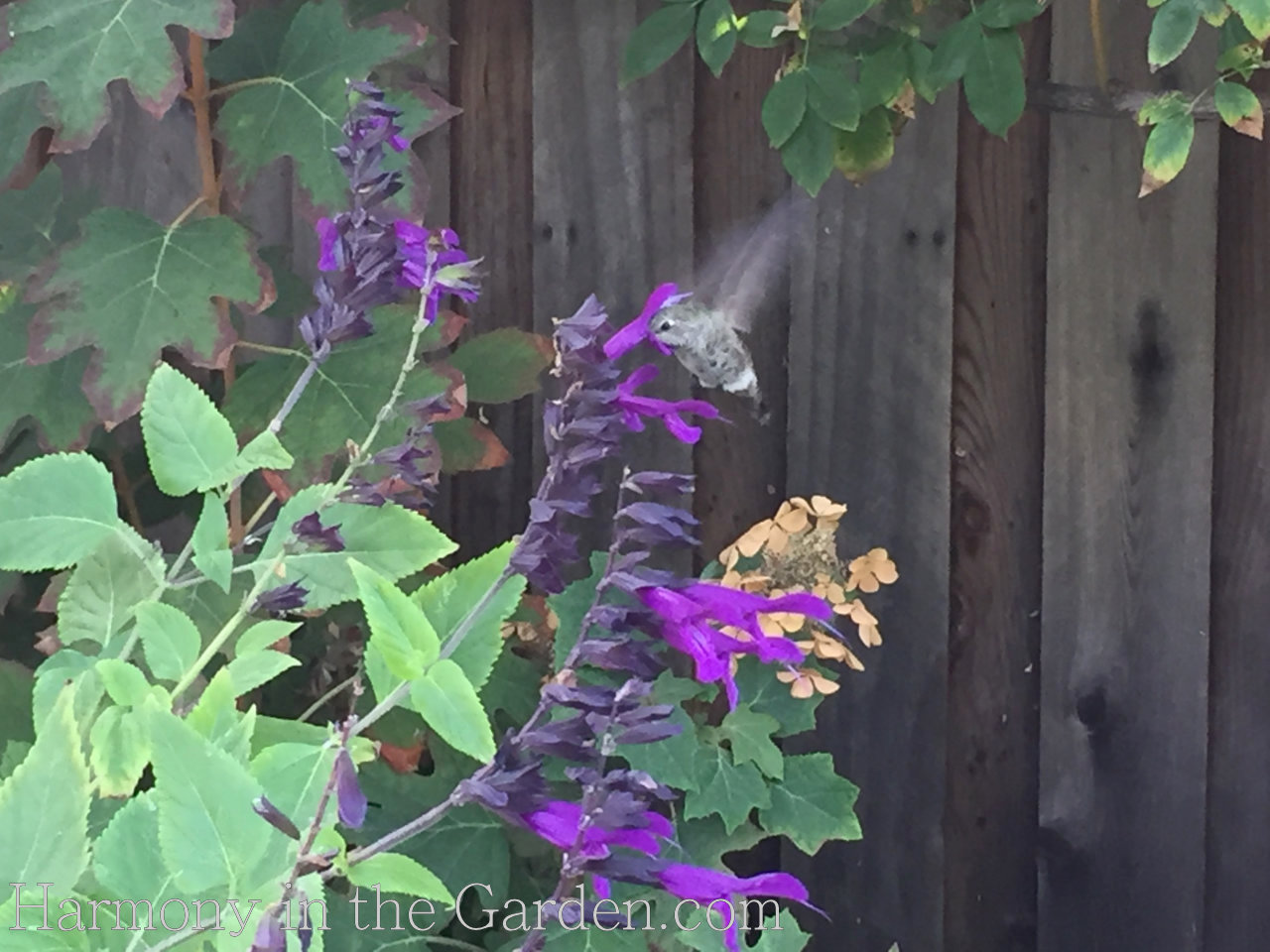
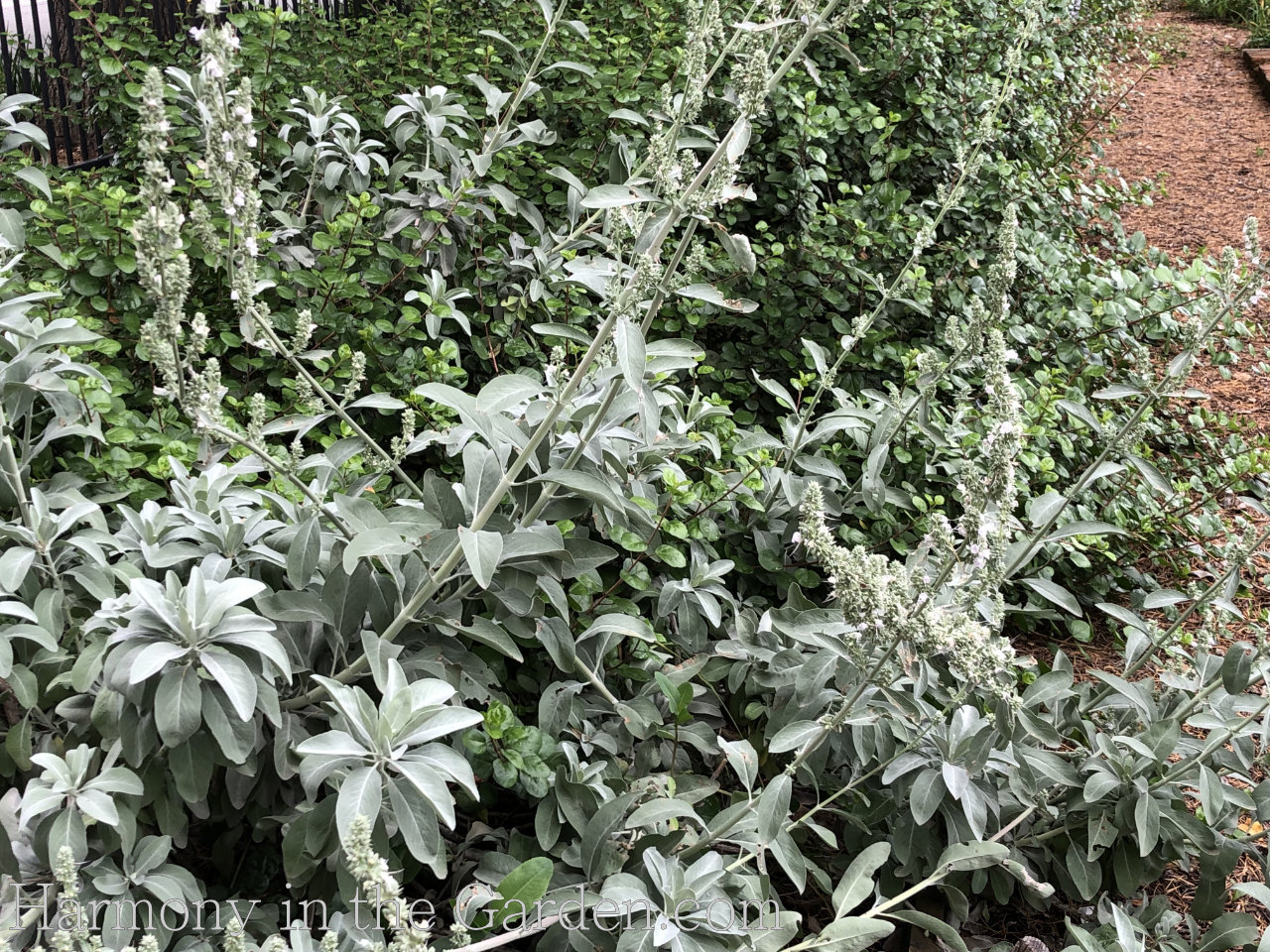
Salvia apiana (White Sage)
Zones 8-9, 5’x5′, full sun
This California native (also called Sacred Sage) quickly grows to a large, rambling shrub.
While beautiful, it definitely benefits from pruning to control size and errant branches.
Click here for 30 of my favorite native plants to use in the garden.
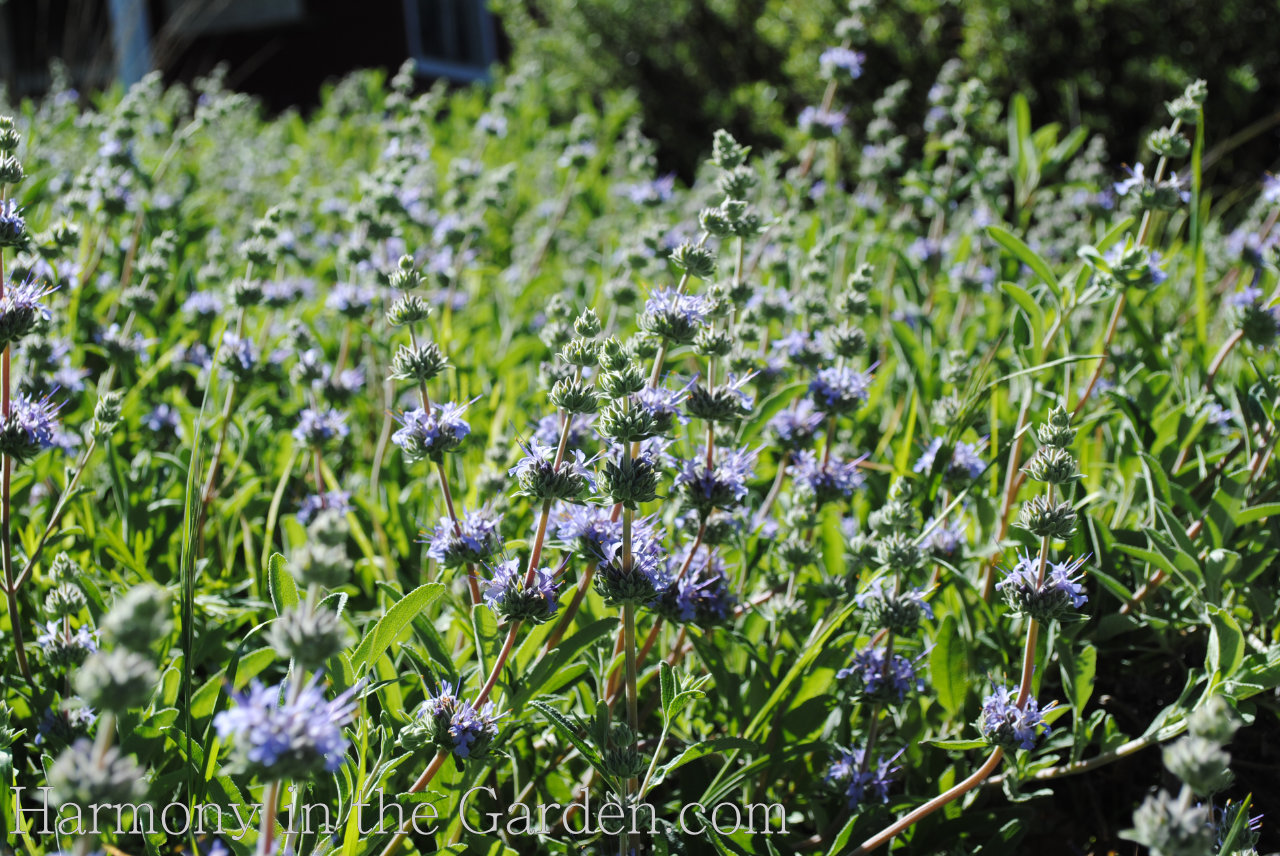
Salvia clevelandii ‘Winifred Gilman’
Zones 8-11, 4’x5′, full sun
This California native (also called Cleveland Sage) is another staple of my designs.
‘Winifred Gilman’ is a bit more compact than the straight species, and is COVERED with whorls of blue/lavender flowers all summer long.
When finished blooming, prune by 2/3 and it’ll quickly fill out to form a lush mound throughout the rest of the year.
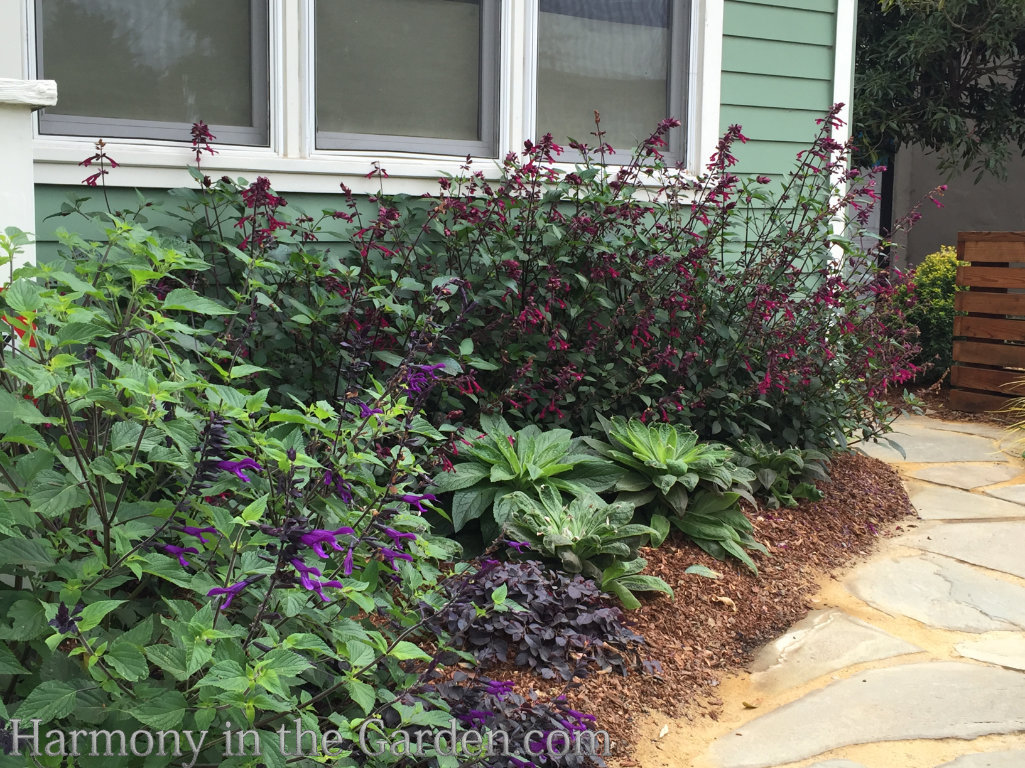
The Salvia ‘Wish’ series
Zones 9-11, 3’x3′, full sun
I just love the story behind the ‘Wish’ series of salvias.
The salvia “Wish” series has its roots in Australia, where every plant sold helps support Make-A-Wish Australia.
The story began when Wendy Smith discovered a unique salvia growing in her garden. Wanting to give back, she named it Salvia ‘Wendy’s Wish’ in honor of the charity.
There’s several salvias in this series, but these are the ones I’ve grown.
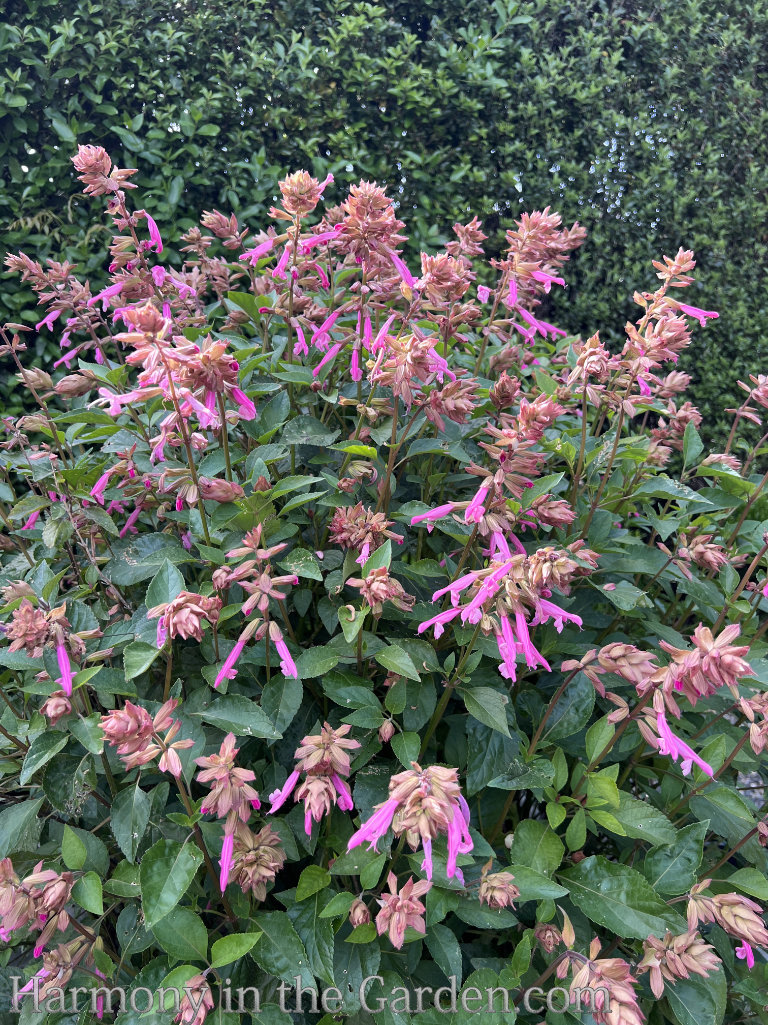

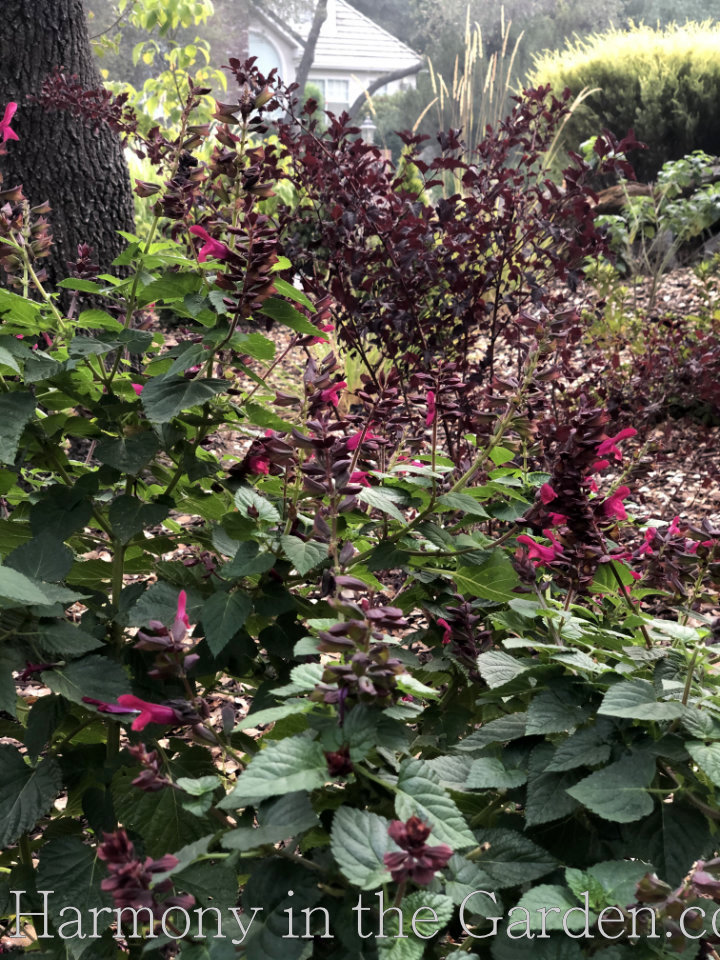
Salvia hybrid ‘Rockin Fuchsia’
Zones 9-11 (annual elsewhere), part sun in my hot climate, 3’x3′.
I couldn’t resist planting this new variety in my garden, as the glowing fuchsia flowers with their black calyxes look fantastic paired with burgundy foliaged plants nearby, like my ‘Diablo’ Ninebark.
Phew! What a long post!
Of course, the salvias I wrote about today are just a few of the 700+ species that are out there!
I’m always on the lookout for more to try so please won’t you let me (and others here) know some of your favorites and why?
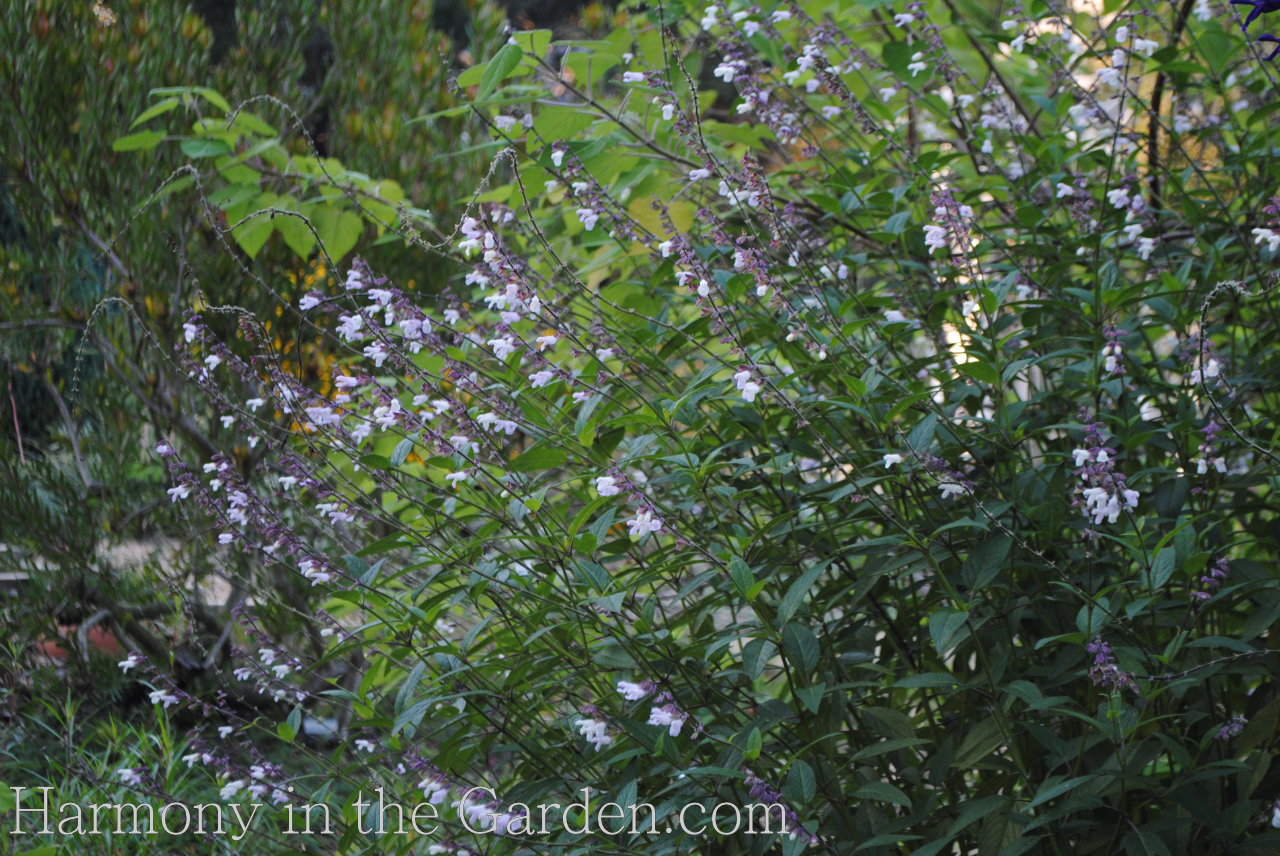
*** Update ***
A longtime reader left a comment below, recommending the book The Plant Lovers Guide to Salvias as an invaluable resource for information about salvias.
I’ve taken a peek at it and couldn’t agree more!!! My copy is on the way!
Oh, and another reader recommends her favorite book ‘The New Book of Salvias’ by Betsy Clebsh.
Thanks everyone!






21 Comments
Hello there, I had Salvia Patens ‘Blue Angel’ a few years ago, one year into the next they appeared. Last years nothing appeared and I think the amount of rain and cold had got to the roots. I bought some more young plants and they flowered happily all summer and autumn. I removed dead stems and foliage in the winter and now looking at the bed, there is no sign of life again at all! However, under the soil is a massive lump of roots, spreading across the whole bed. I have no idea if there is any hope of life or not, should they not be sending up new shoots by this time of year now? Do I did out the roots and start again?
Hello Helen, I live in Northern California (zone 9) and my salvia patens are showing no signs up emerging yet as they’re one of the latest varieties to pop up. However, regarding yours I’m not sure if that’s the case or if they are, indeed, dead. They’re hardy down to zone 8 and since I don’t know where you live perhaps the cold temps is the problem? And I’d be curious what the mass of roots are from – my salvia patens don’t have overly large root masses. My redwoods, however, do and spread throughout my garden beds and often kill tender plants. I’m wondering if the roots you’re seeing are from another thuggish plant? I wish I had a better answer for you, but all I can recommend is waiting a few more weeks to see if they show signs of life and digging around to find the source of all those roots. I wish you good luck!
Thanks so much. That helps, as if there shouldn’t be a mass of roots from them, it might be something else encroaching on their space! I am in the UK, and there has been pretty much constant rain for 3 months solid, so the ground is completely water-logged and some other plants have rotted at the roots, so maybe that’s not helped. We have a lovely open garden near us called Sussex Prairies, which is full of stunning grasses and prairie flowers, salvias and echinacea etc and every year it is just bursting with colours and I wonder how the heck they do it when mine just disappear! However I know they have a professional gardening team and a cutting garden!
Hello Helen, because of all the constant rain you’ve had I sure hope they didn’t rot away – fingers crossed for you! Is your soil fast-draining in that area? The Sussex Prairie sounds absolutely beautiful. Perhaps you can someday ask one of the gardening team what they do (if anything) to keep the salvias from disappearing in the winter – they may have some good tips for you. I just checked mine yesterday and haven’t seen a sign of life from them, but after digging around a bit I can see they’re just slowly waking up. I hope that’s the case with yours, too!
I just discovered FlowersByTheSea.com for their salvia, have been researching their many Z6C-Z9H perennial salvias which need to (here) withstand the occasional, expected Polar Vortex and our every summer saunas in hot & humid N. Dallas. Seems that FlowersByTheSea has just now… autumn 2023… decided to eliminate their online retail sales?! Any ideas for a similar site where I can search for Zones 6-9 plus hot/humid adaptable salvias? Otherwise, I’ll have to stick with a whole bunch more of ‘Sensational!’ and ‘Phenomenal’ Lavender which, as a plus, are ever=green-silver in Z6C.
Hi Barbara, I was so sad to hear they’re no longer selling salvias but thank heavens they’ve kept their informative site for all of us to research. Unfortunately, I don’t have another comprehensive salvia-based site to send you to, except for some that you most likely already know (digging dog, prairie nursery, proven winners, Annies Annuals, etc.) If you find any others I’d sure appreciate you sending me the link so I can pass it along to others. Good luck!!
Thanks for the great article! Got my first Salvia elegans (Pineapple Sage) this year, I love it, will be using the tip for taking cuttings for more next year.
Don’t you just love that salvia, Janis? I so appreciate the late flowers this time of year. And the smell is heavenly!
Such wonderful information! Thanks for sharing, Rebecca. My go-to Salvia book has been Betsy Clebsch’s A Book of Salvias. An updated version, The New Book of Salvias, came out in 2013. Betsy is a wealth of knowledge!
Ah yes…how could I have forgotten that book? Thank you for reminding me (I included it in the post for others to add to their list!) 🙂
Rebecca, as always, I thoroughly enjoyed your article. Salvias are a favorite of mine too. One that I discovered years ago that I love is Salvia buchananii ‘Wendy’s Wish’.. It’s a more open form and has beautiful rose colored flowers with small dark green leaves. I planted it in the front of my beds and let it ramble a bit.
Oh, you’re so right about ‘Wendy’s Wish’, Marie – it’s a gorgeous salvia! I completely forgot about the salvias in the Make-A-Wish line and love them all. For those who don’t know, a proceed of the sale of them go towards this most worthy organization. I have ‘Love & Wishes’ and adore it (though it isn’t blooming right now so I couldn’t include a photo.)
I love your new garden. Can we see a picture of your garden as one garden. To see what it looks like all over.
Many Thanks.
Hi Sally – thanks! My garden is an acre and isn’t able to be photographed as a whole unit. I’ve tried to include larger areas in a few posts that I’ve written about. For example the Pollinator Garden is pretty large and central in the front (you can see it here: https://harmonyinthegarden.com/designing-my-pollinator-garden/, including the first link in that post which is the immediate ‘before and after’. Also, here’s my side yard: https://harmonyinthegarden.com/a-side-yard-makeover-plus-a-huge-giveaway/, and the large area under my back Oak tree: https://harmonyinthegarden.com/gardening-under-oaks-learning-to-love-dry-shade-plants-another-beforeafter/ ) I’ll be writing about another section within the next few weeks (the front entryway), and one of my favorite larger sections a little later on as the plants fill in. I hope that helps a bit! 🙂
Oh yes! I LOVE salivas and have a number of them blooming and growing in my garden, without any effort! It’s the genus of plants that I seem to have the least self-control over when at a nursery! There seem to be almost limitless colors, sizes, shapes and interesting varieties and it’s hard to figure out where to squeeze in one more! I have a lovely large group of pineapple sage growing under a large Fuyu persimmon tree that the hummingbirds use well into Winter. The plants were grown from seed (very easy for this sage) that I brought back from a friend’s house on Maui (the plant is not native there either), since seeds could be brought back, as opposed to stem cuttings, which would have been uncertified plant material (*People must remember not to transport plant material from one area to another, even in California, to avoid transferring pests and diseases – check with your local County Agriculture office or USDA for any pertinent regulations before doing so).
I have a really nice sage in the front garden that I unfortunately lost the tag to long ago. It is probably the hummingbirds favorite sage of all those in the garden and it blooms most of the year, after a brief rest in the hottest part of late summer. It is so easy and free of problems too. It looks somewhat like Salvia ‘Waverly’, with very long flower wands, but I’m not sure that’s what it is. I have John Whittlesey’s book ‘The Plant Lovers Guide to Salvias’, which is really good for showing salvias by type. There is one noted in that book that I would like to find, called Salvia thymoides, that would be really nice in pots. Have you ever grown that one?
Sorry to have written so much, but these plants are amazing!!!!
WOW, Ronnie, thanks so much for all of your information (AND the reminder for us all to be careful when thinking about taking cuttings back to our gardens.) I could’ve written so much more about salvias, but had to draw the line somewhere, so I stopped at just including those that I have in my garden (plus a few others that snuck in.) I haven’t read that book by John Whittlesey but will have to find one asap as it sounds amazing. I had to google the s. thymoides as I’m not familiar with it, but agree it would be darling in a container. I saw a beautiful stand of ‘Waverly’ in Palo Alto’s Gamble Gardens and totally forgot about it. Thanks for reminding me – I’ll have to add it to my collection! 🙂
I’m going to try to find a source for the S. thymoides and will certainly share with you what I find. Thank you for telling me about the s, ‘Waverly’ at Gambel Gardens – I will definitely go an take a look and maybe find that what is in my front garden is in fact the same salvia! For the last 2 summer seasons, Filoli has featured S. viridis, which is grown primarily for the colorful bracts (calyx). Really stunning.
I have to force myself to stop or I’ll drive you nuts with comments! Thank you for indulging me and I hope that you can locate the book. It’s by Timber Press, with copyright and publish date of 2014. The author, John Whittlesey, is a nurseryman, garden designer, and landscape contractor and owned Canyon Creek Nursery in N. California. His website is unfortunately not up to date and I don’t know his current status, but he has an email address on the Canyon Creek Nursery (Oroville CA) website, so you may be able to reach him about sources of harder to find salvias.
Hi Ronnie – I enjoy your comments, keep ’em coming! And I bet other people enjoy them, too – it’s always fun to have dialog happening on my site. Thanks, also, for the contact info re: Canyon Creek Nursery. I sure hope they’ve managed to survive through the fires and everything else happening up there. I’ll try and attach a pic of the ‘Waverly’ salvia I took at the Gamble Gardens. As I recall, it was located closer to the house, vs. further out in the property. Hope that helps you locate it.
Hi Ronnie – just an update to let you know I included your book recommendation at the end of my blog post, along with a photo of salvia ‘Waverly’! Thanks again for your input! 🙂
Thank you for all the information about salvias!!! They are Amazing! AND SO ARE YOU!!!
Thanks so much, Gloria! I’m so glad you enjoyed this article (btw: you’re making me blush at the same time) 😉